Inbox and Environment News: Issue 470
October 18 - 24, 2020: Issue 470
Time of Ngoonungi
The Time of Ngoonungi - Murrai'yunggory — cool, getting warmer (September-October) in the D'harawal calendar of Indigenous Weather Knowledge begins this week. This is the time of the gathering of the flying foxes. A magical time of the year when the flying foxes gather in the darkening skies over D'harawal Lands. They come in from the north-east, the north, the north-west and the west, and swirl over the Sydney area in a wonderful, sky-dancing display just after sunset, before setting off for the night-time feeding grounds to the south.
It is also a very important ceremonial time for the D'harawals, which begins with the appearance of the splashes of the bright red Miwa Gawaian (Telopea speciosissima - waratah) in the bushland.
Waratah (Telopea speciosissima) photo by Selena Griffith - Residents do not state where they have seen these glorious flowers as there are people who come to pick them and steal them for profit. Native plants are protected in New South Wales by the Biodiversity Conservation Act 2016 (BC Act). Under the BC Act it is an offence to pick, possess, buy or sell native plants listed in the Act for commercial purposes without a licence.
Visit: A Bunch Of Wildflowers: Historical Spring September Songs
The D'harawal Country and language area extends from the southern shores of Port Jackson (Sydney Harbour) to the northern shores of the Shoalhaven River, and from the eastern shores of the Wollondilly River system to the eastern seaboard.
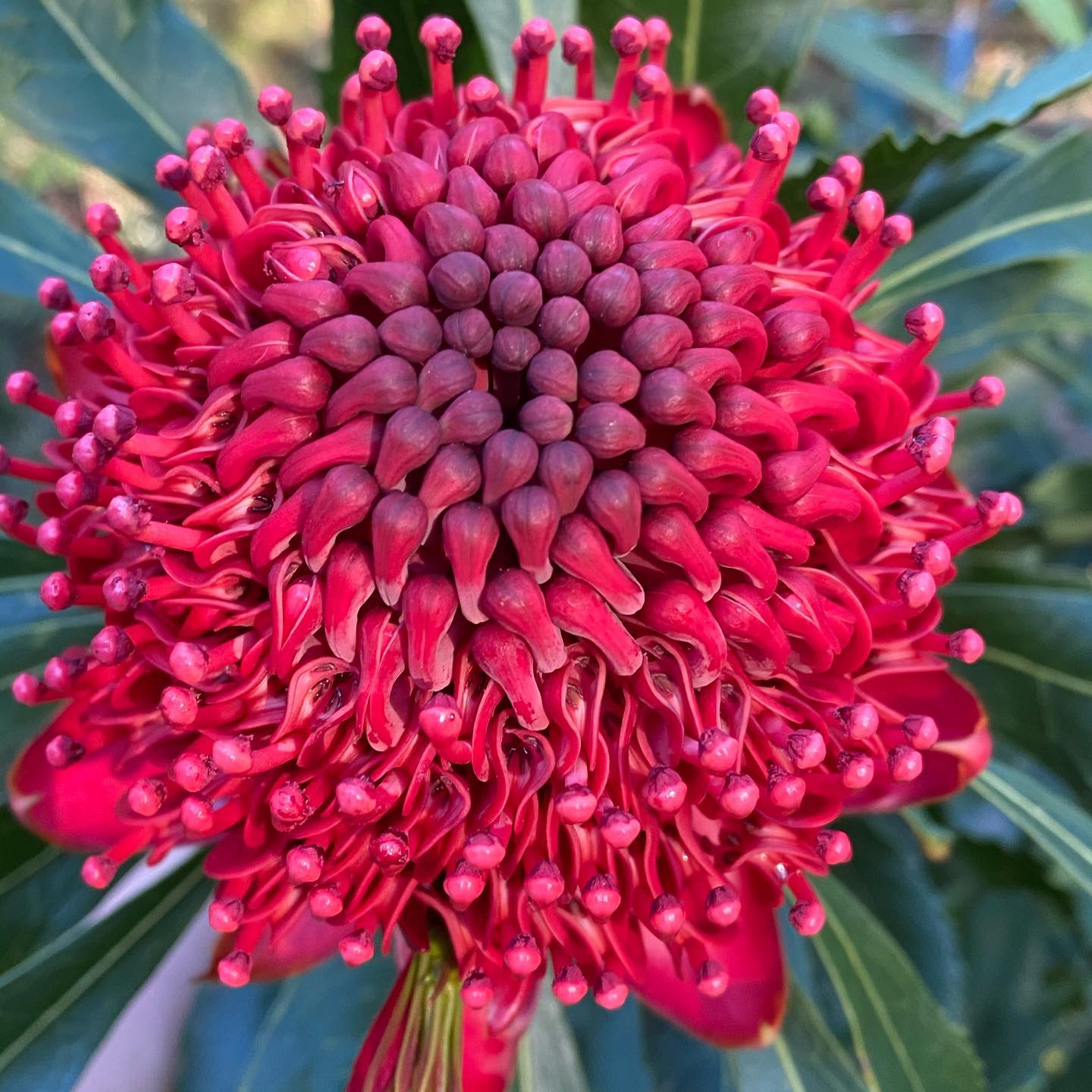
Aussie Back Yard Bird Count 2020
How to get involved
The Aussie Bird Count is a great way to connect with the birds in your backyard no matter where your backyard happens to be — a suburban backyard, a local park, a patch of forest, down by the beach, or the main street of town.
You can count as many times as you like over the week, we just ask that each count is completed over a 20-minute period. The data collected assists BirdLife Australia in understanding more about the birds that live where people live.
Register here: https://aussiebirdcount.org.au
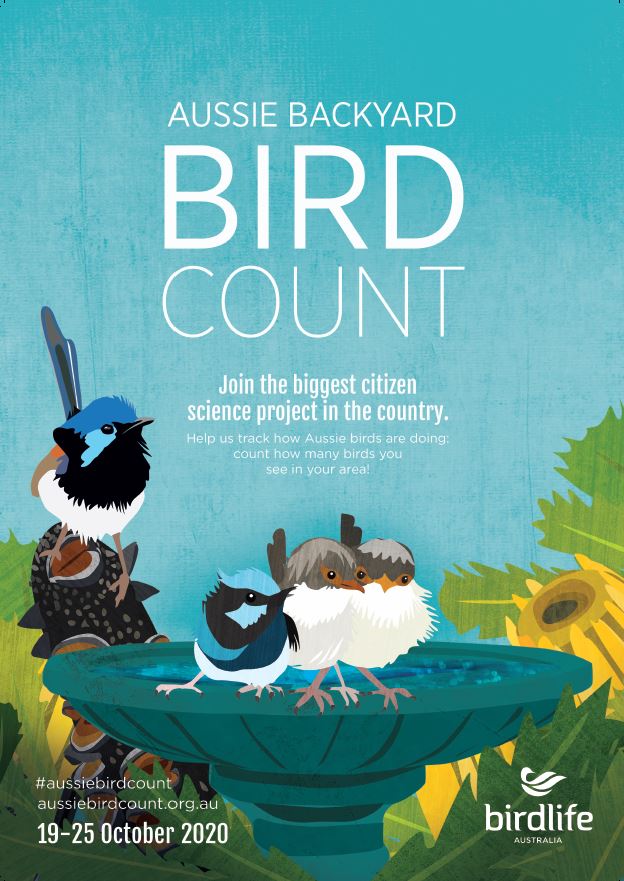
Watch Out On The Pittwater Estuary Water Zones & Beaches: Seals Are About
Residents have filmed and photographed the seals living at Barrenjoey as far south as Rowland Reserve and over at Clareville beach in recent days and ask that people keep an eye out for them and ensure they are kept safe from boat strikes and dogs are kept off the beaches they're not supposed to be on.
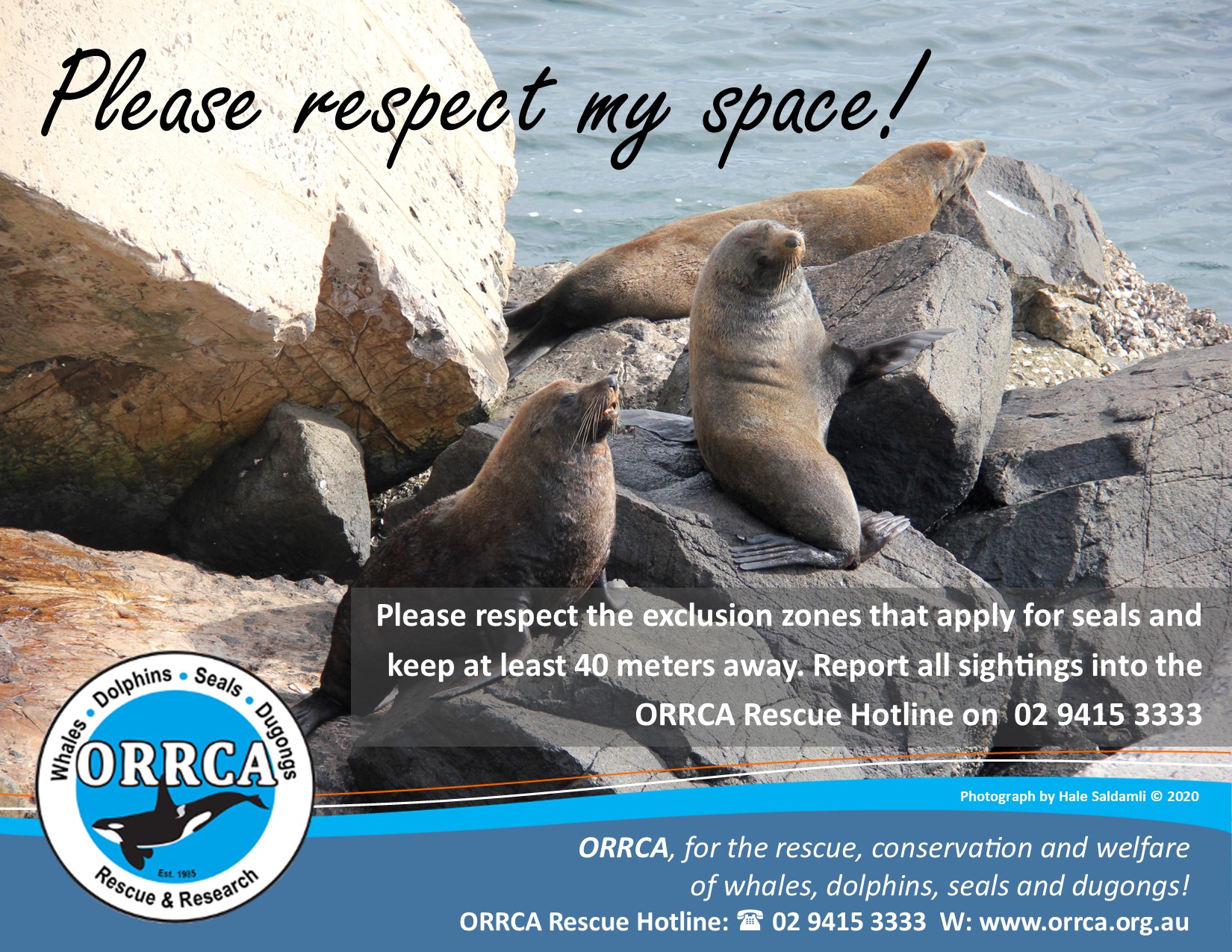
Katandra Season 2020
Katandra Bushland Sanctuary on Lane Cove Rd Ingleside is now open every Sunday until October 25, 10am-4pm. Visitors to this lovely bushland have recently seen Powerful and Boobook Owls, Swamp Wallabies and Lyrebirds. Visitors, please make a small donation towards management of this Crown Land reserve. More details: http://www.katandra.org/home.htm
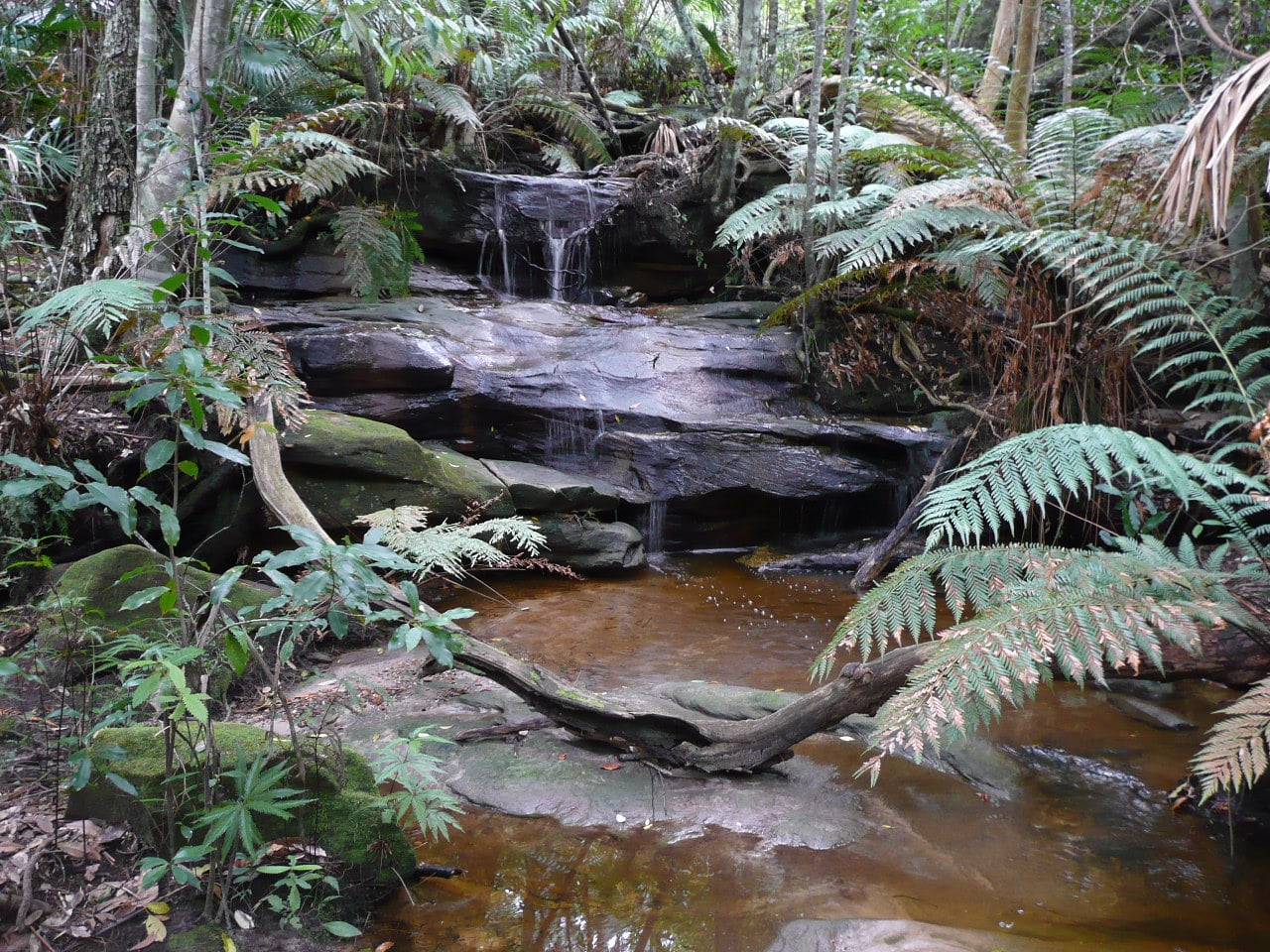
Several creeks flow down the escarpment - photo by Marita Macrae
Bushcare In Pittwater
Where we work Which day What time
Avalon
Angophora Reserve 3rd Sunday 8:30 - 11:30am
Avalon Dunes 1st Sunday 8:30 - 11:30am
Avalon Golf Course 2nd Wednesday 3 - 5:30pm
Careel Creek 4th Saturday 8:30 - 11:30am
Toongari Reserve 3rd Saturday 9 - 12noon (8 - 11am in summer)
Bangalley Headland 2nd Sunday 9 to 12noon
Bayview
Winnererremy Bay 4th Sunday 9 to 12noon
Bilgola
North Bilgola Beach 3rd Monday 9 - 12noon
Algona Reserve 1st Saturday 9 - 12noon
Plateau Park 1st Friday 8:30 - 11:30am
Church Point
Browns Bay Reserve 1st Tuesday 9 - 12noon
McCarrs Creek Reserve Contact Bushcare Officer To be confirmed
Clareville
Old Wharf Reserve 3rd Saturday 8 - 11am
Elanora
Kundibah Reserve 4th Sunday 8:30 - 11:30am
 Mona Vale
Mona Vale Mona Vale Beach Basin 1st Saturday 8 - 11am
Mona Vale Dunes 2nd Saturday +3rd Thursday 8:30 - 11:30am
Newport
Bungan Beach 4th Sunday 9 - 12noon
Crescent Reserve 3rd Sunday 9 - 12noon
North Newport Beach 4th Saturday 8:30 - 11:30am
Porter Reserve 2nd Saturday 8 - 11am
North Narrabeen
Irrawong Reserve 2nd Saturday 2 - 5pm
Palm Beach
North Palm Beach Dunes 3rd Saturday 9 - 12noon
Scotland Island
Catherine Park 2nd Sunday 10 - 12:30pm
Elizabeth Park 1st Saturday 9 - 12noon
Pathilda Reserve 3rd Saturday 9 - 12noon
Warriewood
Warriewood Wetlands 1st Sunday 8:30 - 11:30am
Whale Beach
Norma Park 1st Friday 9 - 12noon
Western Foreshores
Coopers Point, Elvina Bay 2nd Sunday 10 - 1pm
Rocky Point, Elvina Bay 1st Monday 9 - 12noon
Gardens And Environment Groups And Organisations In Pittwater
New Bag Limit For Cockle Collection From October 14
The NSW Government has responded to community concern about the sustainable management of a precious shared resource, and amended bag limits for cockles.
Minister for Agriculture Adam Marshall today announced that bag limits would be reduced to 20 per person per day to ensure balance between managing cockle numbers into the future while still providing a sustainable catch for recreational fishers.
“This reduction in bag limits is a timely response to an issue that has caused concern along our coastal communities, particularly in the Illawarra,” Mr Marshall said.
“Cockles are a shared resource that are harvested recreationally, commercially and for customary purposes, so we have to ensure their sustainability.
“I asked the Recreational Fishing Advisory Committee to consider the current bag limit and advise me on its appropriateness as a matter of priority. It is based upon their recommendation that the procession limit has been reduced from 50 to 20.
“While over-collection is an issue that had to be addressed, today’s announcement is not about Government walking around with a big stick, but rather working with community to meet their expectations.”
Member for Kiama Gareth Ward welcomed today’s announcement, and said that the changes to cockle bag limits would come into effect from October 14.
“The reduction in bag limits is an important step towards responding to community concerns, and is just one measure the NSW Government has implemented to address the over-collection of cockles,” Mr Ward said.
“NSW DPI Fisheries officers already work closely with recreational fishers to ensure compliance as they patrol Lake Illawarra, and last month began Operation Stingray 2 to crack down on cockle poaching.
“Those caught breaking the rules still face substantial penalties, including $500 on-the-spot fines, $200 for not paying the fishing fee, or a maximum penalty of $22,000 and/or six-month imprisonment.”
Over the past five years, fisheries officers have seized more than 100,000 illegally taken cockles and marine invertebrates.
Information on legal fishing and marine invertebrate collecting is available through the free FishSmartNSW App.
Report suspected illegal fishing activity by calling 1800 043 536 or report online.
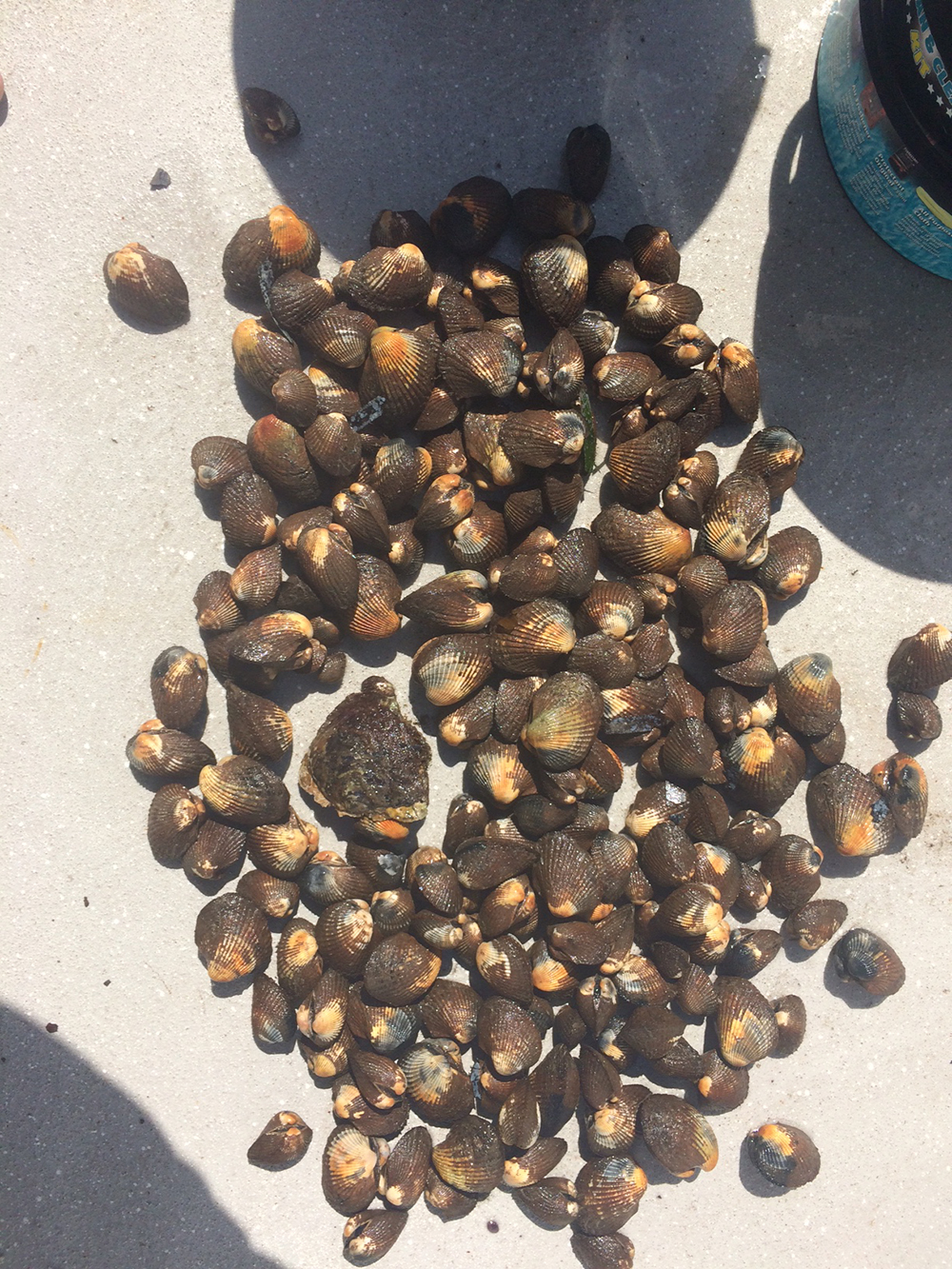
New Signage At Long Reef Aquatic Reserve
The Department of Primary Industries has installed wonderful new interpretative signs at Fishermans Beach. These signs, that replace the old, illegible ones give visitors lots of information about Long Reef Aquatic Reserve and are a welcome addition to the area.
Long Reef Aquatic Reserve was the first aquatic reserve declared in NSW. Since 1980, Long Reef Aquatic Reserve has played an important role in protecting rocky shore plants and animals, and has been an important place for marine education and research.
The reserve is an outdoor classroom, living science research site and recreation hub. It is a home for fascinating marine animals and plants and this year celebrates its 40th Anniversary.
Photos courtesy Wendy Orchard, Fishcare Volunteer (Long Reef).
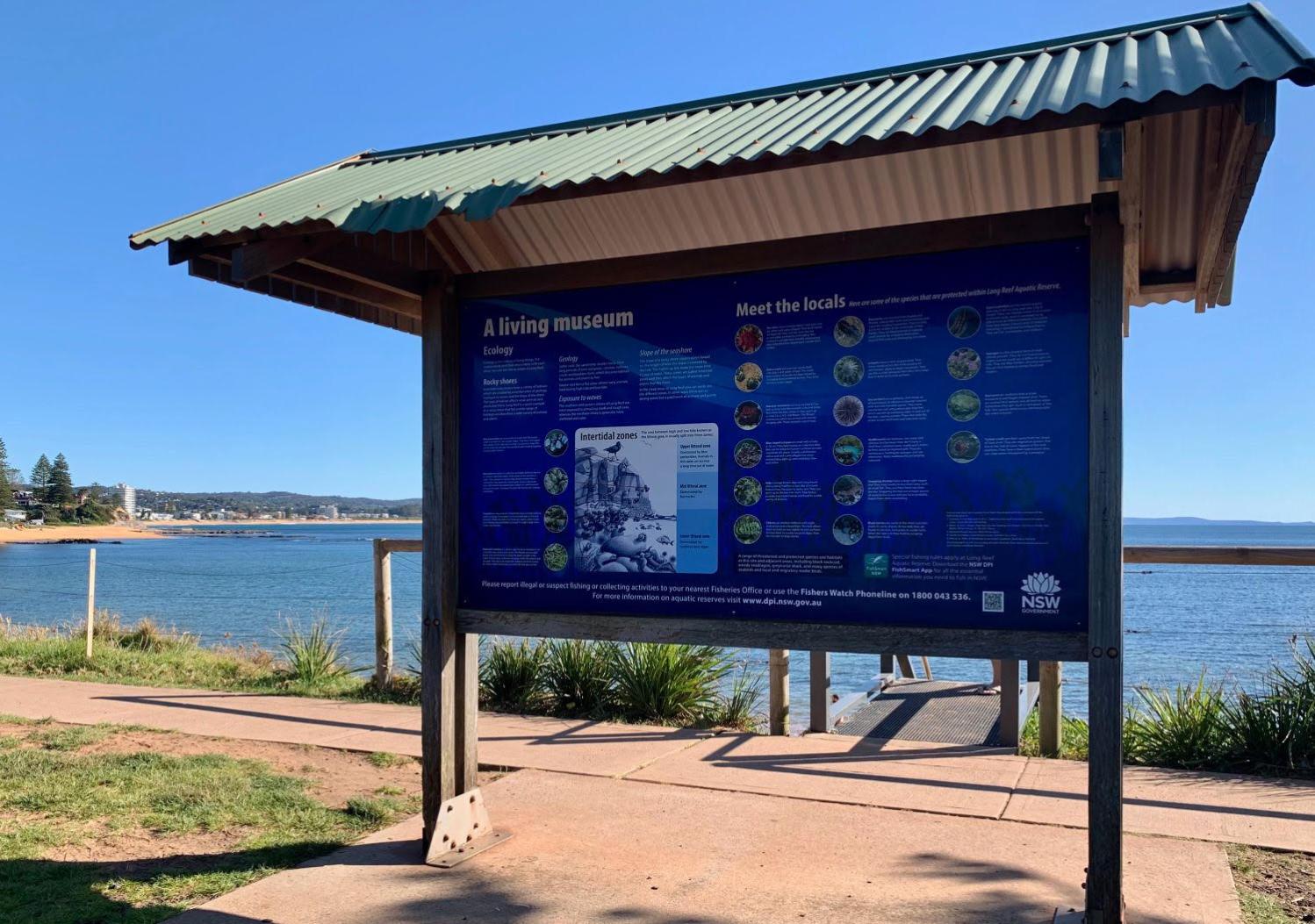
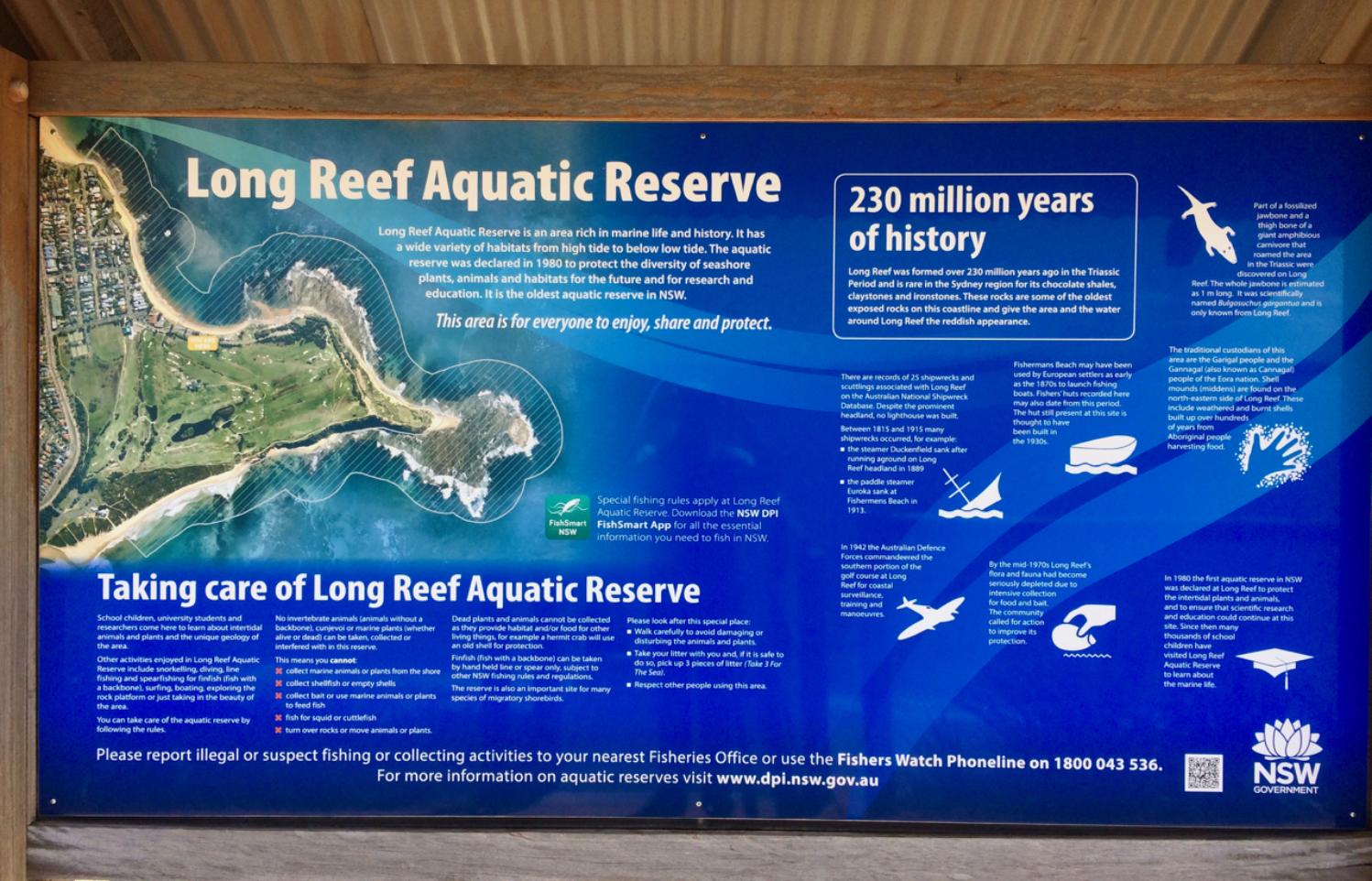
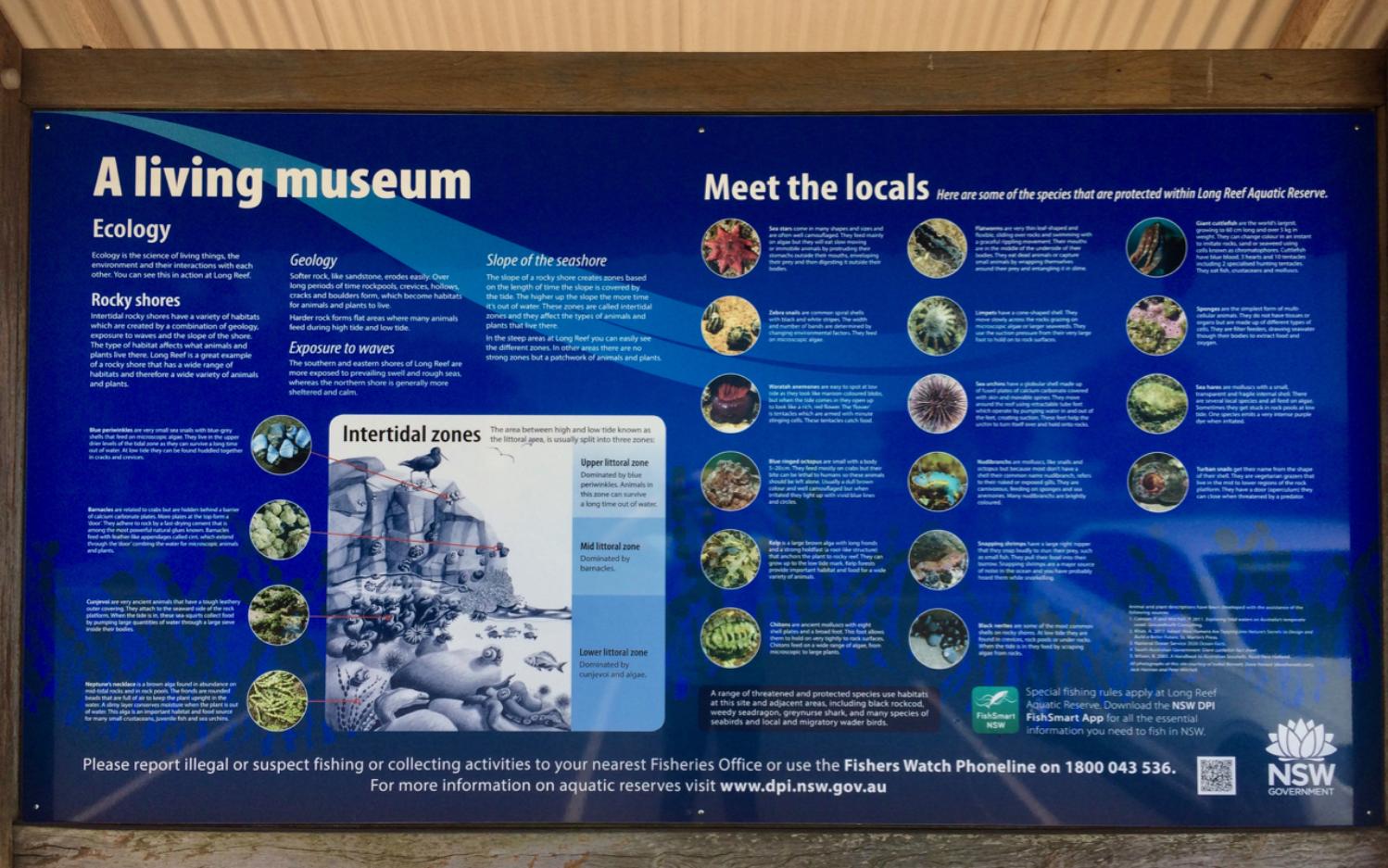
Water Research Laboratory Mushrooms!
Something unusual is growing at the UNSW Water Research Laboratory in Sydney (at Manly Vale). As part of the UNSW Green Impact 2020 initiative, the WRL Green Team recently won a grant to kick-off their ‘Gourmet mushrooms from coffee waste’ sustainability initiative.
The idea is simple: Instead of disposing of our used coffee grounds, they use them to grow edible gourmet mushrooms directly on the site. These are then sold to the WRL community for less than half the price of supermarkets. The earnings are then reinvested to sustain and grow the project.
The WRL Green Team was formed in 2019, to participate in a UNSW pilot program - Green Impact @ UNSW - a competition where staff and students take action to make their office and residential spaces more sustainable. By taking part in UNSW’s Green Impact Challenge the WRL team committed to making the UNSW Water Research Laboratory more sustainable; by promoting team awareness of sustainable work practices, we reduced our impact on the environment and limited wastage of many workplace resources.
The 2019 WRL Green Team led by Kristina Palmer and Grace Carlino had 20 members and won a Silver Award for the number and range of successful sustainability initiatives that were implemented within the WRL workplace during the Green Impact Challenge.
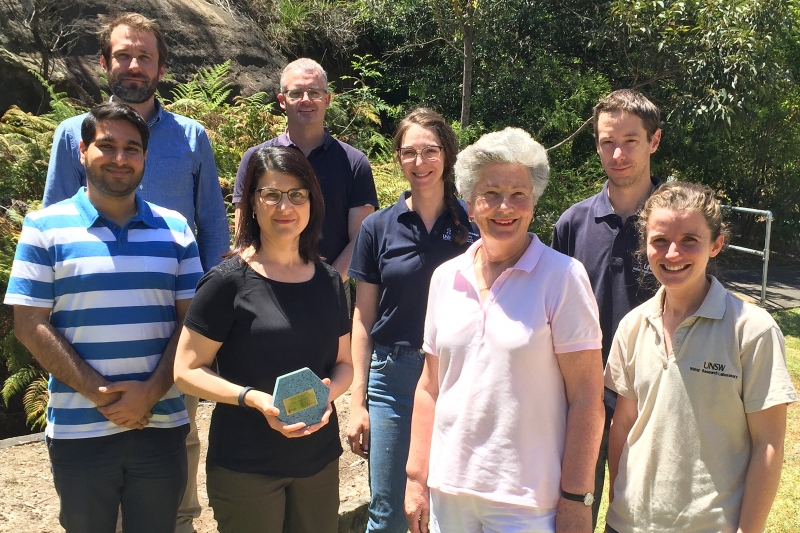
2019 WRL Green Team - Silver Award - WRL photo
Since undertaking Green Impact, WRL’s recycling exploded. Thanks to the WRL Green Teams’ efforts WRL now has systems in place to recycle bread clips, bottle tops, soft & hard plastics, bottles, cans, paper & cardboard, batteries, used mobile phones and toner cartridge collection. The Green Team also created a closed loop for on-site food scrap recycling, where food waste is composted and used to feed the onsite herb garden.
In 2020 Green Impact was back, but had to be adapted due to COVID-19 restrictions which allowed points for more sustainable actions while at home.
The WRL Green Team again agreed to take part in the 2020 Green Impact Challenge and won a small green project grant from UNSW to grow ‘gourmet mushrooms from coffee waste’ at WRL for the wider WRL community. The project, led by Kristina Palmer and Tino Heimhuber (Grace Carlino has stepped in while Kristina is on maternity leave) is still in its infancy, but has proven to be extremely successful.
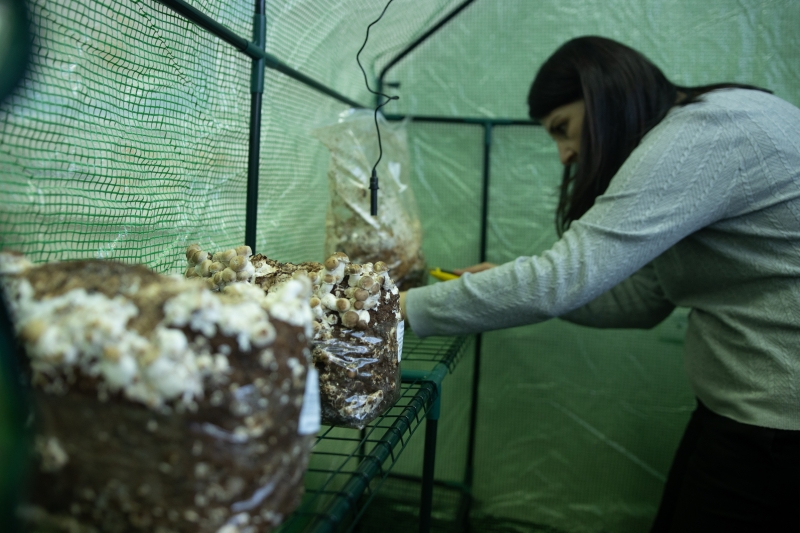
Grace tending the mushrooms- WRL photo
So far they’ve been growing several kilos of Shitake, Oyster and Coral mushrooms from pre-made grow kits and their own coffee grounds - and they have sold out in a heartbeat. Needless to say that these freshly harvested mushrooms taste incredible. The WRL team are still learning every day and now it’s time to ramp up production to meet the growing demand of an excited WRL community, friends and family.
Great stuff!
Central Coast Recycling Company Fined $15,000 For Environmental Breach
October 9, 2020
The NSW Environment Protection Authority (EPA) has fined recycling company IQ Renew $15,000 and issued official cautions to its five directors, for allegedly exceeding waste limits at its Somersby facility on the Central Coast.
IQ Renew operates plants at Somersby and Wyong, processing kerbside (yellow bin) recyclable waste.
EPA Acting Executive Director Regulatory Operations Adam Gilligan said the EPA took action after IQ Renew allegedly breached their Environment Protection Licence by exceeding the 65,000 tonnes permitted waste limit over a 12 month period.
“The potential for pollution to occur increases with poor management of the amount of waste being received at a premises, in conjunction with poor practices.
“IQ Renew has a poor compliance history and inspections by the EPA in the past 12 months have identified poor environmental management and the potential for pollution to occur,” Mr Gilligan said.
The EPA has issued official cautions to the five directors of IQ Renew for failing to prevent the offence after the EPA wrote to IQ Renew in February and August to warn them they may potentially contravene their licence. IQ Renew and its directors failed to act to prevent the offence from occurring and continuing.
“Directors must act responsibly and exercise all due diligence to ensure the company does not commit offences,” Mr Gilligan said.
The EPA fined IQ Renew $48,000 in February this year for alleged offences at its Pile Road, Somersby and Lucca Road, Wyong sites, and a site it occupied in Wisemans Ferry Road, Somersby.
“The EPA has also taken action against IQ Renew or its subsidiaries for a range of environmental breaches over the past seven years.
“We will continue to monitor the performance of IQ Renew to ensure they improve their environmental compliance,” Mr Gilligan said.
Penalty notices are one of a number of tools the EPA can use to achieve environmental compliance including formal warnings, official cautions, licence conditions, notices and directions and prosecutions. In this instance the EPA issued a penalty notice. The notice recipient may pay the penalty notice, seek a review, or elect to have the matter determined by a court.
For more information about the EPA’s regulatory tools, see the EPA Compliance Policy at www.epa.nsw.gov.au/legislation/prosguid.htm
Central Coast Vales Point Power Station Fined $30,000 For Pollution And Waste Offences
October 12, 2020
The NSW Environment Protection Authority (EPA) has fined Sunset Power International Pty Ltd trading as Delta Electricity (Delta) $30,000 for licence breaches at Vales Point Power Station when contaminated material, including asbestos, was allegedly spread on the Central Coast site.
The EPA has issued Delta with two Penalty Notices for allegedly causing land pollution and unlawfully using the premises as a waste facility.
Delta has been progressively rehabilitating various ponds of the Vales Point Power Station ash dam, using a contractor to import excavated natural material to carry out the works.
EPA Director Regulatory Operations Adam Gilligan said Delta advised the EPA in September 2018 that it had identified that material classified as general solid waste had been accepted on the site.
“The premises received waste that it was not licenced to accept, which resulted in contaminated fill being imported and spread on site.”
Mr Gilligan said the EPA has issued Delta with a clean-up notice requiring works to make the site safe, and to assess and quantify the waste.
“The EPA has issued Delta a clean-up notice to remove various surface stockpiles of asbestos waste and we are continuing to liaise with them regarding options for dealing with the remainder of the waste in the long term.
“Fortunately, on this occasion the waste was in an area that posed little risk to the community.”
Since this occurred Delta has made a number of improvements to their systems and procedures regarding accepting waste.
“It is important to be aware of the risks involved when accepting dirt and other materials like this. If the correct procedures are not in place - it can lead to large fines and damage to the environment,” Mr Gilligan said.
The EPA investigates all reports of inappropriate transport or disposal of asbestos and reports can be made to the 24-hour EPA Environment Line on 131 555.
Penalty notices are one of several tools the EPA can use to achieve environmental compliance including formal warnings, official cautions, licence conditions, notices and directions and prosecutions. For more information about the EPA’s regulatory tools, see the EPA Compliance Policy at www.epa.nsw.gov.au/legislation/prosguid.htm
Vales Point Cops Fine For Pollution One Week After Getting $8.7m Federal Government Grant
October 12, 2020
The company that owns Vales Point Power Station last week received a $8.7 million federal government handout has been found illegally dumping asbestos and other waste. [1]
The NSW Environment Protection Authority has issued two penalty notices to Vales Point operator Delta Electricity with fines totalling $30,000(see above).
“How can the federal government justify giving our hard-earned taxpayer dollars to a company that treats the environment and our laws with such disdain?” Nature Conservation Council Campaigns Director Dr Brad Smith said.
“This company has been busted dumping toxic asbestos into an ash dam and spreading it over a very large area. [2]
“The penalty imposed is far too light for such a serious breach — $30,000 is chump change for a man who has made hundreds of millions from deals with the NSW Government.”
Dr Smith said the federal government had no business funding a privately-owned coal-fired power station, especially one that showed such disregard for the environment.
“We call on the NSW Government to block the transfer of the federal grant money to Mr St Baker,” he said.
“We urge the federal government instead to spend that money cleaning up the state’s energy system.”
Mr St Baker applied for taxpayer subsidies under the federal government’s Underwriting New Generation Investments Program and has a record of gaining from government decisions.
He bought Vales Point power station from the NSW Government for $1 million in 2015 and made $113 million in profit on the deal in 2017-18.
Mr St Baker is also a regular political donor and a former National Party electoral candidate.
References
[1] Vales Point Power Station fined $30,000 for pollution and waste offences, NSW EPA, 12 October 2020
[2] Environmental watchdog orders clean-up but residents furious about being kept in the dark, Newcastle Herald, 3-1-2019
Act Now On Wildfires, Global Climate Change, And Human Health; New Australian Study Says
October 13, 2020
Immediate actions are needed to limit the greenhouse gas emissions that are driving climate change that helps fuel wildfires, a Monash University study says.
A special report published in the New England Journal of Medicine, led by Professor Yuming Guo and Dr Shanshan Li from the Monash School of Public Health and Preventive Medicine, summarises the enormous impacts of climate change on wildfire seasons and the sequential increased morbidity, mortality, and mental health impacts.
The report, which analysed numerous studies on wildfires over the past 20 years, says global climate change is fuelling the three essential conditions for wildfires -- fuel, oxygen and an ignition source. The world is seeing inconsistent rainfall, increased drought and hotter temperatures, leading to more flammable vegetation.
It says the global mean carbon dioxide (CO2) emissions from wildfires accounted for about 22 per cent of the carbon emission from burning fossil fuels between 1997-2016. The inconsistent approach to global forest management and the conversion of tropical savannas to agricultural lands is damaging the world's ability to absorb CO2 and cool the climate.
The report says projections suggest that if high greenhouse gas emissions continue, wildfire exposure could substantially increase to over 74 per cent of the global land mass by the end of the century.
However, if immediate climate mitigation efforts are taken to limit the global mean temperature increase to 2.0?C or 1.5?C, a corresponding 60 per cent and 80 per cent, respective increase in wildfire exposure could be avoided, the report says.
Reaching the 1.5°C target would require reducing global net CO2 emissions by about 45 per cent from 2010 levels by 2030 and reaching net zero around 2050. The 1.5°C target remains achievable if CO2 emissions decline by 7.6 per cent per year from 2020 to 2030.
The report says the devastating health impacts are illustrated by several large and -- in some cases -- unprecedented recent wildfires. These include the 2019-2020 Australian wildfires, the 2019 and 2020 Amazon fires in Brazil, the 2018 and 2020 wildfires in the western US, the 2017-2018 wildfires in British Columbia, Canada, and the ongoing record-breaking wildfires on the US West Coast.
Along with the increased eye irritation, corneal abrasions and respiratory impacts of the smoke, the psychological effects are equally as serious with post-traumatic stress disorder (PTSD), depression, and insomnia common. The psychological consequences of wildfire events can persist for years, with children and adolescents particularly vulnerable.
A 20-year study on adults exposed to an Australian bushfire disaster as children in 1983 found an increase in psychiatric morbidity in adulthood, with wildfire events associated with subsequent reductions in children's academic performance.
The report says the current exchange between wildfires and climate change is likely to form a reinforcing feedback loop, making wildfires and their health consequences increasingly severe, unless we can come together to reduce greenhouse gas emissions.
Rongbin Xu, Pei Yu, Michael J. Abramson, Fay H. Johnston, Jonathan M. Samet, Michelle L. Bell, Andy Haines, Kristie L. Ebi, Shanshan Li, Yuming Guo. Wildfires, Global Climate Change, and Human Health. New England Journal of Medicine, 2020; DOI: 10.1056/NEJMsr2028985
NSW Valley A 'Natural Laboratory' To Test Carbon Sequestration Theory
October 12, 2020
Geoscientists at the University of Sydney have discovered a natural laboratory to test claims that the carbon captured during the erosion and weathering of common rocks could be a viable mitigation strategy against global warming.
That laboratory is the Tweed River valley in north-eastern New South Wales.
"When common rocks, known as olivine, chemically break down, they absorb carbon dioxide to form carbonates that can then be washed into the oceans," said lead author of the study, Kyle Manley, a student at the University of Irvine in California, who started the research while studying at Sydney.
"In that way, river valleys like the Tweed can act as carbon sinks."
The carbonates formed in this process later become the shells of marine animals and corals. Over millions of years, these remnants can form huge undersea carbonate structures. Occasionally they are pushed above sea level, such as the White Cliffs of Dover in England.
In order to combat global warming, some have proposed olivine weathering and its carbon capture could be harnessed to absorb millions of tonnes of carbon dioxide from the atmosphere.
"But those ideas haven't really been tested at scale," said Mr Manley, who started the study while on undergraduate exchange at the School of Geosciences at the University of Sydney, completing it at the University of Colorado, Boulder.
Research now published in the journal Frontiers in Earth Sciences, will allow scientists to test these claims in the Tweed catchment area, a 1326 square kilometre region, and in other regions that act as carbon sinks.
Co-author Dr Tristan Salles from the School of Geosciences at the University of Sydney said: "We ran seven scenarios up to 2100 and 2500 to see how much carbon might be absorbed in different climatic conditions.
"In all scenarios we estimate millions of tonnes of carbon dioxide could be absorbed -- but this is a drop in the ocean of the billions of tonnes a year of carbon pollution expected to be emitted over the coming decades and centuries."
The seven scenarios also describe a complex and interconnected interplay between weathering and sea-level rise that will see oceans encroach along the Tweed coast. However, in some areas, extensive weathering will deposit huge amounts of new sediment onto the coastal plain.
Dr Salles said: "Increased global temperatures are likely to see increased rainfall in this part of Australia, which will greatly accelerate the weathering process of olivine rocks.
"Our modelling shows that in some parts of the Tweed floodplain between 3.8 and 6.5 metres of sediment could be deposited. A counter-process will see coastal erosion from the encroaching ocean."
From their initial modelling of the Tweed catchment, the scientists estimate between 57 and 73 million tonnes of carbon dioxide a year could be absorbed in olivine weathering by the end of this century. The United Nations mid-range estimate for carbon emissions at 2100 is about 70 billion tonnes a year, meaning a site like the Tweed catchment would absorb less than 0.1 percent of total carbon emissions.
The scientists used modelling data from the Australian government and the UN's International Panel on Climate Change and from extensive data on the Tweed River valley from Geoscience Australia and the Three Dimensional Great Barrier Reef project (3DGBR).
"Nobody is suggesting that carbon sequestration via olivine weathering will solve our problems," said co-author Professor Dietmar Müller. "But given that there are proposals to artificially enhance this weathering process to absorb carbon pollution, it is important we understand just how viable this could be."
The scientists say that their modelling will assist in the identification of other regions where climate change could create environments in which enhanced natural carbon sequestration might occur.
"What we did find is that the rate and magnitude of sea-level rise is the dominant control of where, when and how much sediment is deposited in such a region," Mr Manley said.
"Climate change will throw these river systems out of equilibrium, so there is still much work to do to understand how they will operate as natural carbon sinks."
Kyle Manley, T. Salles, R. D. Müller. Modelling the Dynamic Landscape Evolution of a Volcanic Coastal Environment Under Future Climate Trajectories. Frontiers in Earth Science, 2020; 8 DOI: 10.3389/feart.2020.550312

Plastics Threat To South Pacific Seabirds Confirmed
October 14, 2020
by Canterbury Museum
Plastic gathered from remote corners of the South Pacific Ocean, including nesting areas of New Zealand albatrosses, has confirmed the global threat of plastic pollution to seabirds. Published on 12 October in the journal Aquatic Conservation: Marine and Freshwater Ecosystems, the study looks for patterns in the plastics seabirds from around the South Pacific ingest. It uses data gathered by Canterbury Museum Senior Curator Natural History Dr Paul Scofield and Wellington ornithologist Christopher Robertson in the late 1990s and 2000s.
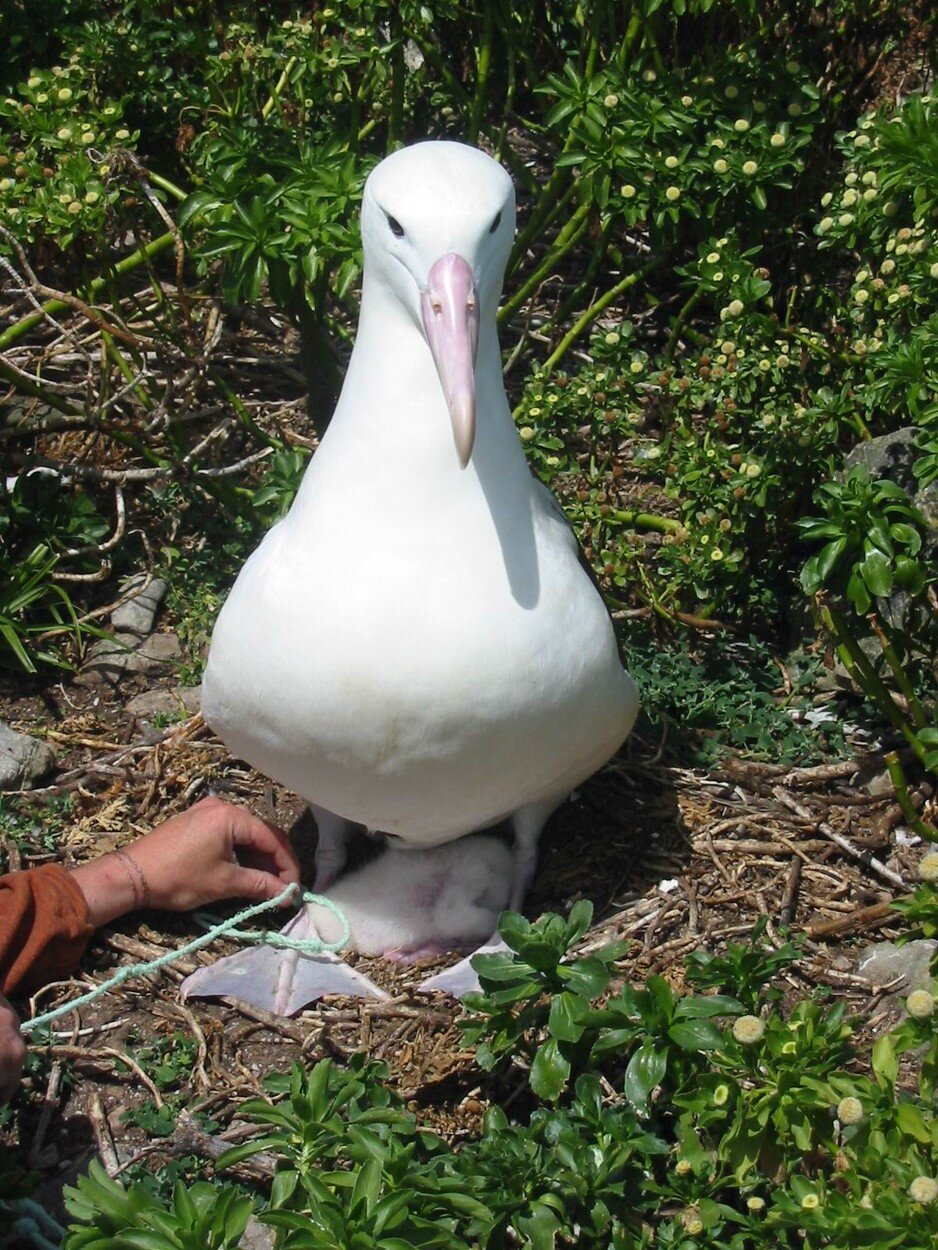
Northern Royal Albatross nesting on Big Sister, north of Rekohu (Chatham Island)
"Plastic pollution is a major threat to seabird species, not just here in New Zealand but around the world," says Dr Scofield. "Knowing more about how seabirds interact with plastic might help us solve this problem in the future. At the moment, it's only getting worse."
Christopher Robertson, co-author of the study says, "One of the interesting takeaways from this study is that it shows you just how far plastic can travel in the ocean. Some of the areas where we collected the plastic are very remote. To me, that shows that this is a global issue; it's not something a single country can solve on its own."
"The samples provided by our colleagues from New Zealand allowed us to assess the patterns of seabird-plastic interactions on a larger scale, across the entire South Pacific Ocean," says the study's lead author, Valeria Hidalgo-Ruz from the Chilean Millenium Nucleus Centre of Ecology and Sustainable Management of Oceanic Islands.
"The results confirm that even seabirds in one of the most remote areas of the world, the Rapa Nui (Easter Island) ecoregion, are strongly affected by this global problem, highlighting the need for urgent solutions."
In the late 1990s and 2000s, fieldworkers gathered thousands of pieces of plastic from albatross nesting sites on the Chatham Islands, Campbell Island and Taiaroa Head in Otago. The birds swallowed most of the plastic while foraging at sea and then regurgitated it at the nesting sites as they tried to feed their chicks.
Between 2003 and 2004, the team also examined plastic from the stomachs of Sooty Shearwaters killed by fishing operations around the Chatham Rise and the southeast coast of the South Island.
The study compared these plastics with similar samples from other locations around the Pacific including coastal Chile and Rapa Nui. The researchers examined the types of plastic found along with their shape, colour and density.
Albatrosses are more likely to eat brightly-coloured plastic, in particular red, green and blue. The birds probably mistake these objects for prey. The study suggests the brightly-coloured fishing gear of commercial fishing operations around the Chatham Islands and in Chile could be the source of some of the plastic found at those nesting sites.
Plastics found in the stomachs of diving seabirds like the Sooty Shearwater were dominated by hard, white/grey and round plastic items. The researchers believe most of these objects are ingested accidentally when the birds eat fish or other prey that have consumed plastic.
The ingestion of marine plastics is a major issue for seabird conservation and will affect most seabird species by 2050, according to estimates.
This work was partially funded by the Department of Conservation's Conservation Science Levy and New Zealand Ministry of Primary Industries.
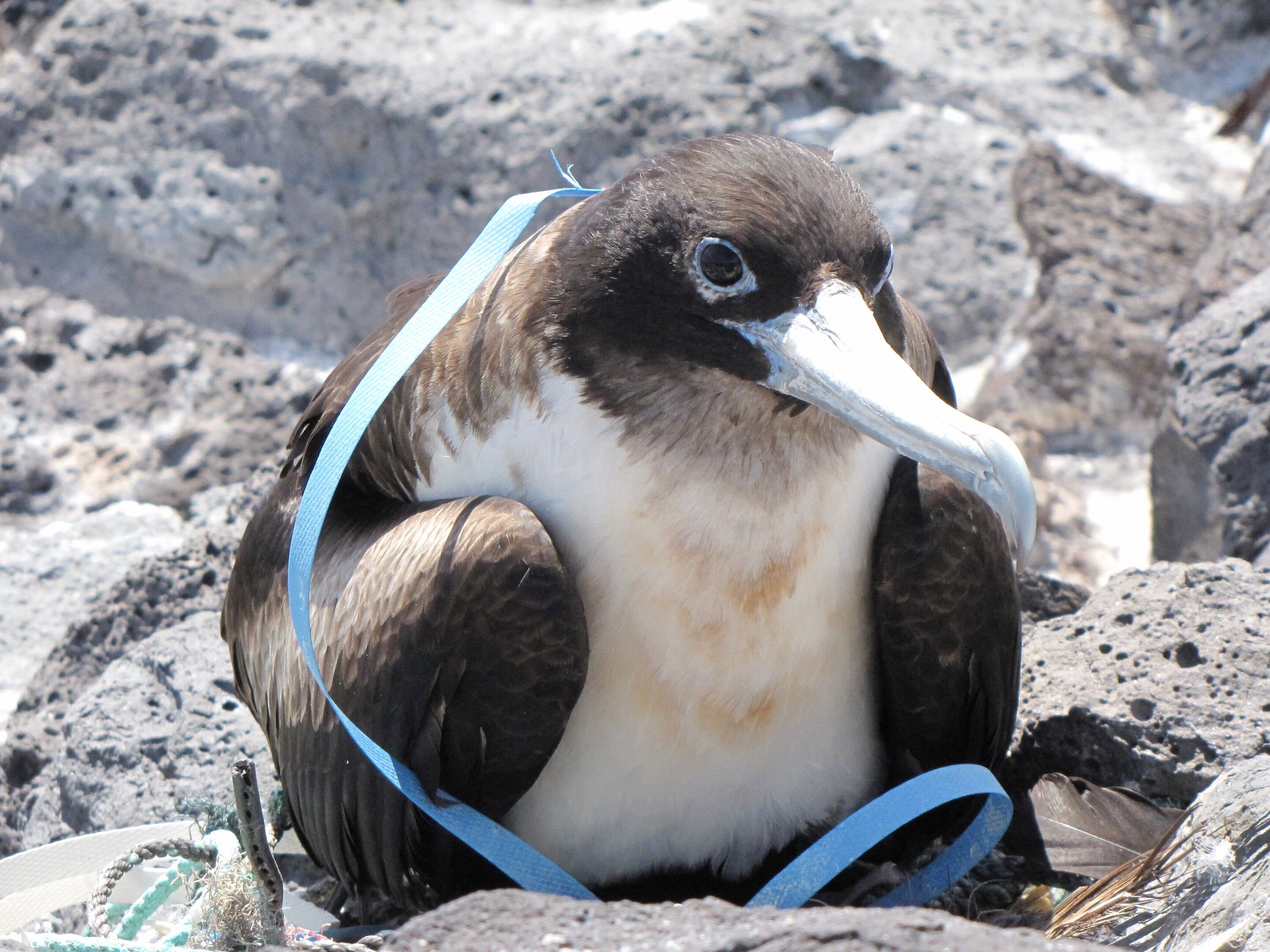
Great Frigate Bird tangled in plastic, Desventuradas Islands, Chile. Credit: Diego Miranda
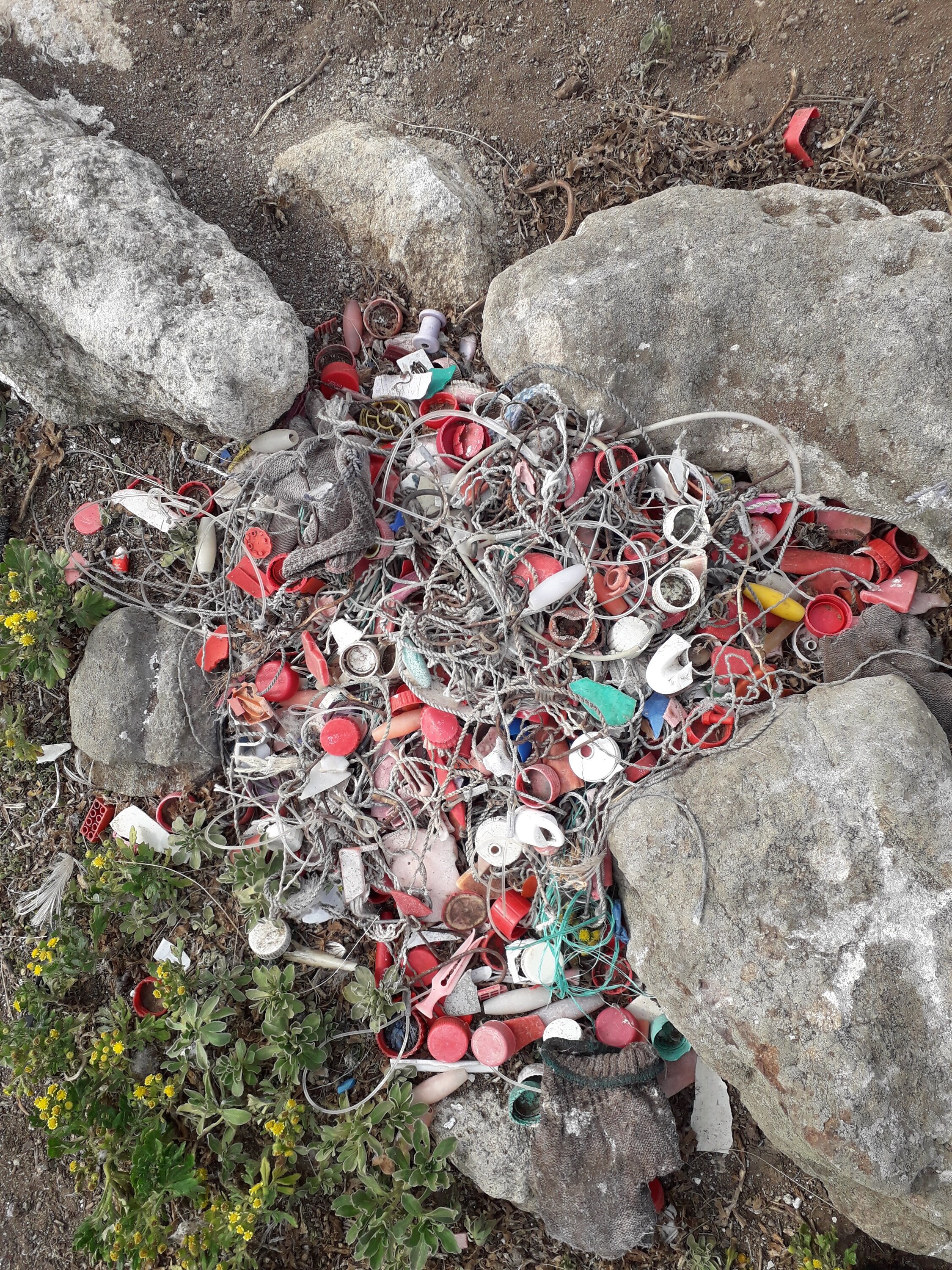
Plastics collected from albatross nesting sites on Big Sister in 2017. Credit: Mike Bell
Valeria Hidalgo‐Ruz, Guillermo Luna‐Jorquera, Marcus Eriksen, Hanna Frick, Diego Miranda‐Urbina, Matias Portflitt‐Toro, Marcelo M. Rivadeneira, Christopher J.R. Robertson, R. Paul Scofield, Juan Serratosa, Cristián G. Suazo, Martin Thiel. Factors (type, colour, density, and shape) determining the removal of marine plastic debris by seabirds from the South Pacific Ocean: Is there a pattern? Aquatic Conservation: Marine and Freshwater Ecosystems, 2020; DOI: 10.1002/aqc.3453
'Critical' Status For Billion-Dollar Regional Pumped Hydro Project
October 12, 2020
The billion-dollar Oven Mountain pumped hydro project has been declared Critical State Significant Infrastructure by the NSW Government, kick-starting the country’s largest Renewable Energy Zone and unlocking opportunities for 600 regional jobs.
Energy Minister Matt Kean said that pumped hydro was essential for the State’s energy future and works by pumping water up the hill when energy is cheap and letting it run down the hill when the sun isn’t shining and the wind isn’t blowing.
“The Australian Energy Market Operator says that NSW needs more than twice the energy storage of Snowy 2.0 again by the mid-2030s and projects like Oven Mountain can help us reach that goal,” Mr Kean said.
“It can take about 8 years to deliver massive pumped hydro projects and we need to get going now to create jobs and improve the reliability of the energy grid.”
Water Minister Melinda Pavey said the project would be an essential part of the local future water infrastructure.
“The project will include the construction of two reservoirs, tunnels and a new underground power station, creating jobs and critical water infrastructure with the potential to operate as a water source for firefighting and water security for Kempsey,” Mrs Pavey said.
“The infrastructure will enable water from the lower reservoir to be pumped into the upper reservoir using excess power from other renewable energy projects. It is then released to generate up to 600MW of hydro power during periods of peak demand.”
Member for Northern Tablelands Adam Marshall said that regional NSW has some of the best pumped hydro resources in the world and coming out of the COVID-19 recession we should be using those resources to create jobs.
“Oven Mountain could inject more than $1 billion of investment into our region and create up to 600 new local jobs during construction alone,” Mr Marshall said.
“This project is the jewel in our region’s renewable energy crown and cements the New England as the renewable energy powerhouse of Australia.
“We’re already home to the two largest windfarms in NSW and the largest solar farm in Australia is about to start construction, so this project is the cherry on top of us!”
The proponent will now need to request assessment requirements for the preparation of an Environmental Impact Statement (EIS). Once received, the EIS will go on exhibition for community feedback and detailed assessment by the Department of Planning, Industry and Environment before a final decision is made.
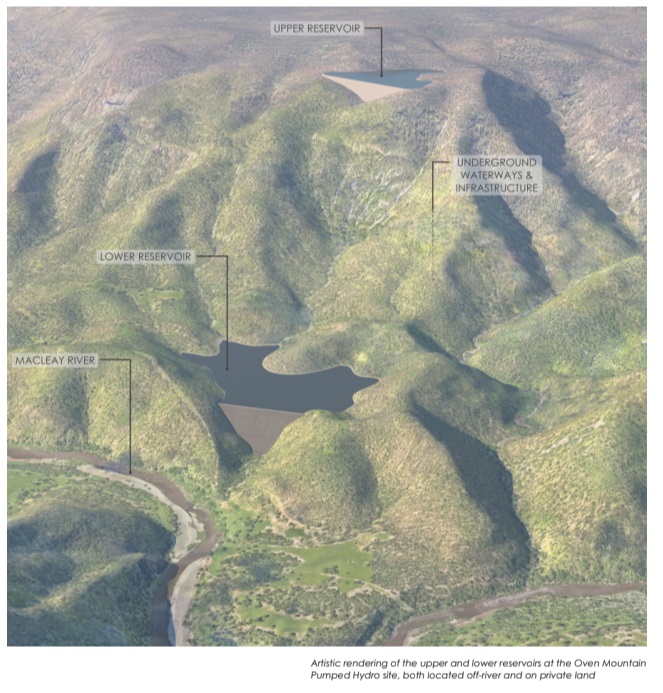
Cameras Capture Parmas Pottering Post Fire In Gibraltar Range National Park
October 12, 2020
Cameras have captured potoroos and parma wallabies playing and parenting post fire in the hard-hit Gibraltar Range National Park, in a welcome sign of recovery.
National Parks and Wildlife Service Ranger Koen Dijkstra said the camera shots along with recent fauna surveys show the importance of refuge areas for fighting back after fire.
"The unprecedented fires across Gibraltar Range and Washpool National Parks devastated the landscape with only a few areas unscathed.
"Among the sites we saved around Mulligans Hut camping area and Gibraltar House were some of the prime habitats for long nosed potoroo and parma wallaby, so we were hopeful some of these species had survived.
"Now we have proof. Fauna surveys over winter, coupled with night camera vision show healthy parma wallabies and potoroos just doing their thing.
"We can see potoroos playing and parenting, including one cleaning a joey in the pouch.
"In another caught on camera moment a parma wallaby displays some very deft tool using skills to get to a lure, a mix of peanut butter, oats and honey locked under a cap used to attract wildlife to the camera.
"The fauna surveys showed numbers of species in the burnt areas were very low, but the unburnt patches are teeming with wildlife including the wallabies and potoroos as well as spotted-tailed quolls, greater gliders and Rufous scrub-bird.
"These animals will be the base from which to re-colonise the fire-impacted area and the success of recent extensive pest control work will be a crucial factor.
"It's particularly pleasing as both parma wallabies and long nosed potoroos are listed as vulnerable in NSW, with Gibraltar Range National Park a stronghold.
"In Gibraltar Range we were very lucky that we had good rain a few months after the fires and the vegetation is recovering fast.
"Many plant species impacted by fire such as the soft grevillea have seedlings emerging in large numbers. Re-sprouters like the glorious Gibraltar Range Waratah have grown back healthy and might even flower this year.
"Even though the burnt areas are recovering, walking into the refuge areas really soothes the soul and gives me hope our beautiful parks will return to their former glory.
"We are optimistic more surveys over summer will continue to reveal further signs of recovery," Mr Dijkstra.
After working around the clock fighting the fires, NPWS staff have worked very hard on pest and weed control as well as restoring visitor facilities.
With the exception of the "Washpool Walk" all visitor facilities and attractions in Gibraltar Range and Washpool national parks are open. For the latest updates check the website Washpool National Park.
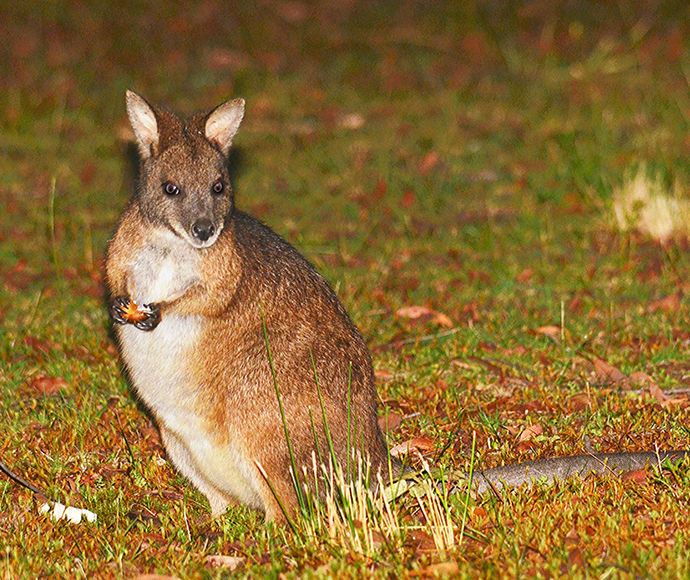
Parma Wallaby (Macropus parma) Photo: Mark & Bernice O’Mahone
Spring Nesting Flow For Drought-Hit Murray Cod In The Macquarie River
October 12, 2020
Drought-hit Murray cod in the Macquarie River will receive a helping hand during their spring breeding season, with water for the environment set to be delivered throughout October and November.
The flow, managed by the NSW Department of Planning, Industry and Environment and the Commonwealth Environmental Water Office (CEWO), will help native fish recover after three years of record drought, and fish deaths in February and March this year.
Department of Planning, Industry and Environment's Senior Wetlands and Rivers Conservation Officer Tim Hosking, said the flow aims to balance multiple objectives including supporting Murray cod nesting season in the Mid-Macquarie River, helping with drought recovery in the Macquarie Marshes and connecting the Lower Macquarie River with the Barwon River.
"Besides being an endangered species, Murray cod are an important recreational fishing species and have significant cultural value to the First Nations in the Macquarie catchment," Mr Hosking said.
"This flow is informed by the latest science on Murray cod nesting in the Macquarie from DPI Fisheries and will deliver stable flow conditions throughout early October to help this protected species nest and move through the system".
Matt Hansen from Inland Waterways OzFish said maintaining stable flows to ensure nests are not exposed or disturbed will help to improve the likelihood of successful Murray cod breeding and support their recovery.
"After countless volunteer hours were exhausted to rescue fish through some terrible drought years, it is great to see flows designed to stimulate breeding and help the recovery. We lost thousands of fish that were decades old recently, with the intensity of the drought just proving too much," said Mr Hansen.
The Commonwealth Environmental Water Holder, Jody Swirepik, said although the Macquarie Marshes has received some decent rain, this internationally important site needs more water to recover from extended drought and fire impacts.
"Providing water during warmer spring conditions for long enough will help ensure vegetation, frogs, fish and birds can complete their lifecycles," Ms Swirepik said.
"The Macquarie Marshes are an important breeding site for a wide range of waterbirds including the endangered Australasian bittern, colonial nesting waterbirds and migratory birds.
"The flow will also help golden perch travel back into the Macquarie Catchment. We saw this happen in Autumn 2017 when flows helped connect the Macquarie and the Barwon rivers."
Monitoring by the Department during and after the flow will include remote sensing of how much of the Marshes were inundated, how long the water stayed in the landscape and surveys of how waterbirds and frogs responded. NSW DPI Fisheries will also conduct fish surveys to identify the hatching dates of larval Murray cod, to help environmental water managers tailor nesting flows more effectively in future.
The flow of up to 107 gigalitres is now possible due to recent allocations combined with carried over water that was previously suspended due to the drought. The timing and pattern of releases in late spring will benefit Murray cod and will not coincide with larger irrigation demands expected in December. Flows will be managed adaptively by local staff to make the most of the water available and mitigate, where possible, any disruptive inundation in the event of significant rainfall.
Planning for this flow has been undertaken in collaboration with the Macquarie Cudgegong Environmental Water Advisory Group, which includes landholders, irrigation and environment groups, Local Land Services, and First Nations representatives.
NSW Government Finalises Koala SEPP
October 7, 2020
The NSW Government has agreed on the details of the koala protection policy, which strikes a balance between safeguarding the future of our national icon while ensuring certainty for farmers.
Amendments to the State Environmental Planning Policy (Koala Habitat Protection) 2019 (Koala SEPP) and the Local Land Service Act 2013 were agreed to by ministers last night.
Acting Deputy Premier Paul Toole said the agreement is a balanced outcome that will protect koalas, protect their habitat and protect farmers’ property rights.
“The new agreement will separate land management and private native forestry from the SEPP so farmers can continue their farming operations without getting weighed down in green tape,” Mr Toole said
“Farmers face enough uncertainty with seasonal conditions and volatile markets - it is critical they have certainty around rules that apply to their farming practices as they bounce back from bushfires and drought.”
Minister for Planning and Public Spaces Rob Stokes said that the NSW Government had been working over many months to strike a balance between protecting the koala and the rights of our farmers.
“I’m pleased to say we have hit the mark,” Mr Stokes said
“Last night’s resolution demonstrates that there are often important robust and passionate discussions as part of the decision-making process. The koala is an iconic Australian animal and saving it from extinction in the wild is the goal of this policy.”
The NSW Government has agreed the following in order to reverse the decline of the State’s koala population:
- Retaining the 123 tree species that have been scientifically proven to be critical to koala survival, as habitat and feed source
- Refining the definition of ‘core koala habitat’, meaning it must be either a highly suitable habitat and koalas are present, or highly suitable habitat and there is a verified record of koalas
- Decoupling the Private Native Forestry and the Land Management Codes within the Local Land Services Act 2013 from the Koala SEPP on the basis robust protections already exist;
- Strengthening landholder rights when a local council creates a Koala Plan of Management by extending minimum exhibition timeframes, introducing clear dispute pathways for landholders and ensuring they can access ecologists or use their own to appeal or object to what a council has put forward;
- Removing the pink Development Application Map in favour of returning to an on-the-ground survey method; and,
- Refining the blue Site Investigation Map and making it available to local councils.
The final Koala SEPP will be taken to the Executive Council for approval by the Governor as soon as possible and Guidelines will be published on Friday, 16 October. The NSW Government will introduce amendments into the Parliament to the Local Land Services Act 2013 this year.
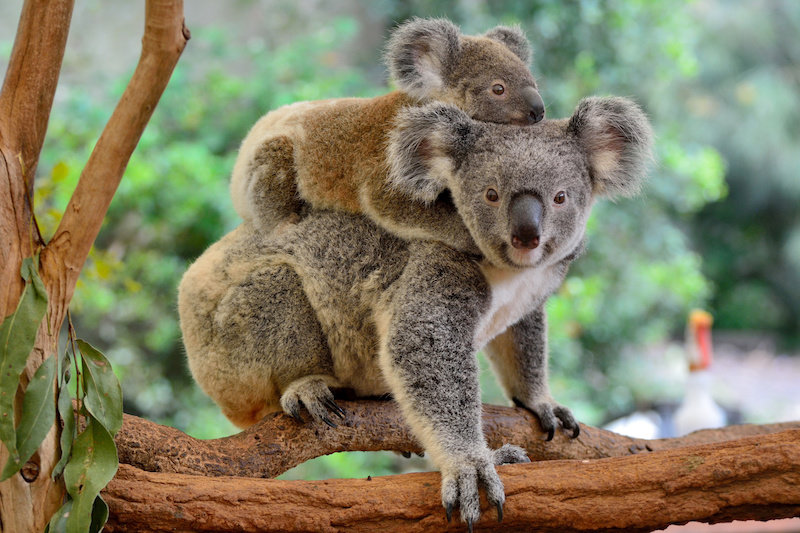
Analysis: The Truth About The NSW Koala SEPP
In September the NSW Nationals threatened to break up the state’s governing coalition over a koala protection policy they say creates an unfair amount of “red and green” tape for farmers. But as EDO Policy and Law Reform Director Rachel Walmsley writes, the regulation is a minor update that does not do enough to protect koala habitat.
Of all the policies in the world to get upset about, this is really not one of them. There has been a lot of misinformation about the NSW Government’s planning policy on development in areas of koala habitat – the State Environmental Planning Policy (Koala Habitat Protection) 2019 (Koala SEPP) – that needs to be clarified. The current political debate appears to be triggered by assessment requirements proposed in a draft guideline being prepared under the updated SEPP – itself a subordinate regulatory instrument, which has already been in operation since March 2020. There is no change to the legislation that currently allows the clearing of koala habitat in NSW.
The new SEPP is one limited legal tool intended to help koalas, and on our expert analysis (see below) the SEPP will remain largely ineffective in addressing the exacerbated threats currently facing them. It took just weeks for almost a quarter of koala habitat in NSW to be burnt in the bushfires, while it has taken the NSW Government 10 years to update the list of relevant koala habitat trees in the SEPP and fix up the definition of core koala habitat. The need for enforceable and effective laws is now more urgent than ever. The suggestion that this limited policy should be further weakened is 100% politics and 0% evidence-based.
Here are 10 facts about the new Koala SEPP:
- The new Koala SEPP is a minor strengthening of an existing instrument. There has been a policy setting out requirements for plans and development assessments in core koala habitat since 1995.[1]
- It is standard practice for Development Application processes to require assessment of impacts on a threatened species. This is not new, not unusual, and not unreasonable for a species headed for extinction.
- The Koala SEPP does not prohibit the clearing of koala habitat. In fact, outside of national parks, no areas of koala habitat are off limits to development under NSW laws.
- The Koala SEPP only applies for development that requires development approval under planning laws – the rules for routine farming activity and rural land clearing have not changed. That is, the Koala SEPP may apply to a farmer lodging a development application to their local council to carry out development in koala habitat, but it’s highly likely that such a development would have required assessment under the previous SEPP anyway.
- The relationship between the Koala SEPP and land clearing laws has not changed. Even if areas become mapped as core koala habitat under a comprehensive koala plan of management (a mechanism in both the former and current koala policy, and one that requires consultation and approval), and subsequently code-based clearing is excluded from those sensitive regulated areas, farmers can still apply and get approval to clear koala habitat under land clearing laws.
- The definition of koala habitat has been expanded due to the fact that the list of relevant tree species has been updated to improve scientific accuracy. While there are now 123 species identified, the listings are region specific and some regions such as Riverina, only list 9 relevant species. It has taken 10 years to update the definition of koala habitat so that it is scientifically accurate.
- Both the former and new Koala SEPPs apply to specified local government areas, (excluding National Parks and State Forests), and only on land over one hectare.
- Under the new SEPP, where a proposed development has low or no impact on koala habitat, no survey is required.
- The new SEPP does not rezone land, and the option for Councils to do a Koala Plan of Management is still voluntary, and involves consultation.
- Koala populations are headed for extinction by 2050 (or sooner) unless their habitat is protected. The policy under debate is still nowhere near the standard of regulation needed to effectively protect habitat of this iconic species.
Read our detailed analysis of the SEPP reform process:
The new NSW SEPP – State Environmental Planning Policy (Koala Habitat Protection) 2019 – commenced on 1 March 2020. With koala numbers having been in decline in NSW over the past two decades, a revised Koala SEPP was highly anticipated as an opportunity to bolster legal protections for koalas. Frustratingly, the finalised Koala SEPP does little more than tinker around the edges. The fact remains that NSW laws fall far short of providing tangible protection for koalas. And with koala populations and their habitats significantly impacted by the summer’s devastating bushfires, it’s going to take more than just a few revisions to provide our koalas and their habitats the real legal protection they need.
The status of koalas in NSW
Koalas are currently listed as a vulnerable threatened species in NSW, meaning there is a high risk of extinction in the medium-term.[2] Additionally, individual populations at Hawks Nest and Tea Gardens on the lower north coast, between the Tweed and Brunswick Rivers east of the Pacific Highway in the Northern Rivers area and within the Pittwater Local Government Area in northern Sydney are listed as endangered populations.[3]
Accurately estimating koala numbers is difficult. Despite regulations, policies and community initiatives, overall koala numbers in NSW are in decline. In 2016, the NSW Chief Scientist relied on the figures of Adams-Hoskings et.al. in estimating approximately 36,000 koalas in NSW, representing a 26% decline over the past three koala generations (15-21 years).[4] We note however that other reports suggest koala numbers are even lower than this.[5]
These estimates were made before the catastrophic bushfire events of this summer, which have been devastating for koalas, with estimates showing that more than 24% of all koala habitats in eastern NSW are within fire-affected areas.[6] Many people are asking how our environmental laws can help conserve and restore vulnerable wildlife at this time – this is something that EDO continues to look at as we start to move forward from the events of this summer (see our response to Australia’s climate emergency).
A new state environmental planning policy is one legal tool intended to help koalas, but on our analysis the SEPP will remain largely ineffective in addressing the exacerbated threats currently facing them. It took just weeks for almost a quarter of koala habitat in NSW to be burnt in the bushfires, while it has taken the NSW Government 10 years to simply update the list of relevant koala habitat trees in the SEPP. The need for enforceable and effective laws is now more urgent than ever.
Key changes to the NSW Koala SEPP[7]
On 1 March 2020, the NSW State Environmental Planning Policy No 44 – Koala Habitat Protection (SEPP 44)[8], which has been in place since 1995, was repealed and replaced by a new State Environmental Planning Policy (Koala Habitat Protection) 2019 (new Koala SEPP).[9]
SEPP 44 aimed to protect koalas and their habitat, but its settings were weak and not targeted at the type or scale of projects with highest impact. Additionally, the problematic definitions of core koala habitat and potential koala habitat were adopted by other legislation (including the Local Land Services Act 2013 (LLS Act) and the Biodiversity Conservation Act 2016 (BC Act)), where they were used as a benchmark for triggering processes and regulation relating to land clearing and development assessment.[10]
EDO has been calling for changes to SEPP 44 for the best part of a decade. In December 2010, EDO wrote to the Government on behalf of Friends of the Koala noting that SEPP 44 ‘is in urgent need of reform’.[11] In 2016, the Government announced a review of SEPP 44.[12] EDO made a submission on the Review of the Koala SEPP outlining our key concerns with its operation and making recommendations for improvement.[13] It wasn’t until fires began burning across the state late last year that the Government announced the release of the new Koala SEPP, just days before Christmas.
Despite recommendations that the Government consult on the text of a draft SEPP and any relevant guidelines or supporting material following its 2016 review, the final SEPP was made without any additional consultation; but it does address a number of stakeholder concerns. Most significantly, it updates the definition of ‘core koala habitat’ and removes the problematic concept of ‘potential koala habitat’, instead relying on mapping (a new Koala Development Application Map and new Site Investigation areas for Koala Plans of Management Map) to initially identify koala habitat. However, certain legal mechanisms still apply only to core koala habitat.[14]
The new SEPP also updates the list of feed tree species in Schedule 2, used to help identify koala habitat, from 10 species to 123 species, categorised into 9 distinct regions. Other key changes include:
- Removing the requirement for site specific plans of management (in instances where a comprehensive Koala Plan of Management is not in place), instead requiring decision-makers to take into account new standard requirements in a Koala Habitat Protection Guideline. Concerningly, the Guidelines have not yet been seen, there are no formal requirements for developing the Guidelines (e.g. no requirements for community consultation or peer review) and the standards within the Guidelines are not mandatory – the new Koala SEPP requires only that they be taken into account.
- Moving provisions relating to how local environment plans and other planning instruments should give effect to protection to koalas from the SEPP to a new Ministerial planning direction (which is yet to be made).
Ongoing concerns
There are also a number of key concerns that have not been addressed by the new Koala SEPP. For example:
- No areas of koala habitat are off-limits to clearing or offsetting – NSW laws do not prohibit the clearing of koala habitat. Despite declining koala numbers and the devastation caused by this summer’s fires, NSW laws still allow koala habitat to be cleared with approval. The new Koala SEPP simply requires decision-makers to ensure development approvals are consistent with koala plans of management (PoMs) or, if a PoM is not in place, that the (yet-to be-made) Guidelines are taken into account. If our laws are to truly protect koalas and their habitats then the approval process must not allow important koala habitat to be offset or cleared in exchange for money, in the way that the NSW Biodiversity Assessment Method does. Rather, all development that has serious or irreversible impacts on koala habitat must be refused.
- The requirement for councils to prepare Comprehensive Koala PoMs remains voluntary – Due to the slow uptake by councils (only 5 comprehensive PoMs have been finalised since SEPP 44 commenced in 1995),[15] EDO has previously recommended that the preparation of comprehensive koala PoMs (CKPoMs) be mandatory (i.e. the SEPP require that draft CKPoMs be prepared and exhibited within a particular timeframe).
- The new Koala SEPP still only applies to limited types of development – As was the case with SEPP 44, the new Koala SEPP still only applies to council-approved development. This means that the new Koala SEPP does not apply to the wide range of development and activities that can impact on koala habitat, including complying development, major projects (State significant development and State significant infrastructure), Part 5 activities (e.g. activities undertaken by public authorities) and land clearing activities requiring approval under the LLS Act.
- The 1 hectare requirement has not been removed – The arbitrary threshold of 1ha for triggering SEPP 44 has been carried over to the new Koala SEPP. Excluding sites below 1ha from the Koala SEPP leaves small koala habitat areas, particularly koala habitat in urban areas, without adequate protection. The 1 hectare requirement also contributes to cumulative impacts and can reduce connectivity across the landscape by allowing small patches to be cleared.
- Climate change considerations have been overlooked – The review of SEPP 44 provided an opportunity to incorporate requirements to identify and protect habitat and corridors that will support koalas’ resilience to more extreme heat and natural disasters, even if there is no koala population in those areas now, however there is nothing in the new Koala SEPP that specifically addresses climate change.
- Monitoring and compliance requirements have not improved – There are no new requirements relating to monitoring, review, reporting and compliance in the new Koala SEPP.
The future for NSW koalas
The new Koala SEPP highlights the overarching deficiencies in NSW laws to provide genuine protections for wildlife and nature. The way our laws are designed, very little is off limits to development or activities such as urban development, mining, and agriculture. While environmental laws provide processes for assessing environmental impacts, at the end of the day weak offsetting laws and discretionary decision-making powers allow destructive activities to go ahead to the detriment of our wildlife and natural resources. Contradictory policy settings in NSW laws mean that laws aimed at conserving biodiversity and maintaining the diversity and quality of ecosystems (such as the BC Act) are undermined by other legislation that facilitates forestry, agricultural activities and developments (such as the LLS Act, Forestry Act 2012 (Forestry Act) and Environmental Planning and Assessment Act 1979 (EP&A Act)).
Many of the recent initiatives by the NSW Government to address koala conservation have focused mainly on funding and policy, without substantial legislative or regulatory reform to increase legal protections for koala populations and habitat. The new Koala SEPP is no exception. While some improvements have been made, particularly in relation to the definition of core koala habitat, overall many concerns remain and the Koala SEPP is unlikely to result in improved outcomes for koalas.
Until our laws are strengthened to truly limit or prohibit the destruction of koala habitat, koala populations and their habitat will continue to be at risk and koala numbers will continue to decline in NSW, possibly to the point of local extinction.
References
- [1] The former State Environmental Planning Policy No. 44 – Koala Habitat Protection, commenced in 1995.
- [2] Biodiversity Conservation Act 2016, s 4.4(3)
- [3] See www.environment.nsw.gov.au/threatenedSpeciesApp/profile.aspx?id=20300; www.environment.nsw.gov.au/threatenedSpeciesApp/profile.aspx?id=10615 and www.environment.nsw.gov.au/threatenedSpeciesApp/profile.aspx?id=10614
- [4] NSW Chief Scientist & Engineer, Report of the Independent Review into the Decline of Koala Populations in Key Areas of NSW, December 2016 above no 6, citing Adams-Hosking, C, McBride, M.F, Baxter, G, Burgman, M, de Villiers, D, Kavanagh, R, Lawler, I, Lunney, D, Melzer, A, Menkhorst, P, Molsher, R, et al. (2016). Use of expert knowledge to elicit population trends for the koala (Phascolarctos cinereus). Diversity and Distributions, 22(3), 249-262. doi: 10.1111/ddi.12400
- [5] See, for example, Paull, D., Pugh, D., Sweeney, O., Taylor, M.,Woosnam, O. and Hawes, W. Koala habitat conservation plan. An action plan for legislative change and the identification of priority koala habitat necessary to protect and enhance koala habitat and populations in New South Wales and Queensland (2019), published by WWF-Australia, Sydney, which estimates koala numbers to be in the range of 15,000 to 25,000 animals. In 2018, the Australian Koala Foundations estimates koala numbers in NSW to be between 11,555 and 16,130 animals, see www.savethekoala.com/our-work/bobs-map-%E2%80%93-koala-populations-then-and-now
- [6] See Department of Planning, Industry and Environment, Understanding the impact of the 2019-20 fires, https://www.environment.nsw.gov.au/topics/parks-reserves-and-protected-areas/fire/park-recovery-and-rehabilitation/recovering-from-2019-20-fires/understanding-the-impact-of-the-2019-20-fires
- [7] See https://www.planning.nsw.gov.au/Policy-and-Legislation/Environment-and-Heritage/Koala-Habitat-Protection-SEPP
- [8]See https://www.legislation.nsw.gov.au/#/view/EPI/1995/5
- [9] See https://www.legislation.nsw.gov.au/#/view/EPI/2019/658
- [10] As noted earlier in our submission, for example, for the purpose of the land management regime under Part 5A of the Local Land Services Act 2013, category 2-sensitive regulated land (on which clearing is more strictly regulated) is to include ‘core koala habitat’.
- [11] EDO NSW Submission on State Environmental Planning Policy No 44 – Koala Habitat, December 2010, available at https://d3n8a8pro7vhmx.cloudfront.net/edonsw/pages/3547/attachments/original/1485908888/Attachment_A_-_2010_EDONSW_SEPP_44_Submission_for_FOK.pdf?1485908888
- [12] See https://www.planning.nsw.gov.au/Policy-and-Legislation/State-Environmental-Planning-Policies-Review/Draft-koala-habitat-protection-SEPP
- [13]See https://d3n8a8pro7vhmx.cloudfront.net/edonsw/pages/3547/attachments/original/1485908884/170131_Koala_SEPP_44_Review_Submission_-_FINAL_to_DPE.pdf?1485908884
- [14] For example, under clause 9 of State Environmental Planning Policy (Koala Habitat Protection) 2019, which applies to development on land for which no PoM is in place, the Guidelines will not apply if a suitably qualified and experienced person provides information that the land is not core koala habitat. [15] There are only approved plans for five council areas, and a further nine Councils who have drafted or undertaken koala habitat studies See https://www.environment.nsw.gov.au/topics/animals-and-plants/native-animals/native-animal-facts/koala/koala-conservation
Australian Academy Fellows Say It’s Time To Establish An Independent Biodiversity Agency In Australia
October 14, 2020
With Australia failing to halt species decline and our biodiversity management systems broken, now is the time to establish a new independent agency to manage our nation’s biodiversity data, according to Australia’s leading scientists.
The recommendation by the Australian Academy of Science is part of a brief that has been sent to all Australian MPs and senators ahead of debate, expected in the Senate in November, on the Australian Government’s Environment Protection and Biodiversity Conservation Amendment (Streamlining Environmental Approvals) Bill 2020.
The government is arguing that the legislation forms part of phase one of Professor Graeme Samuel’s proposal for reform, with the amendments described as the first tranche of reforms associated with the legislative review of the EPBC Act.
Australian Academy of Science Fellow, Professor Craig Moritz, said the Academy welcomes the interim findings of the Samuel review.
“The Academy holds that all the recommended elements—National Environmental Standards, scientific evidence through high-quality data and analysis tools, and robust and independent assurance systems—are essential to ensure that devolved decision-making retains the confidence of the Australian people,” Professor Moritz said.
“The Samuels report is a comprehensive program for reform and should be pursued systematically and in full. In this context, parliamentary scrutiny to understand the implications of the Bill and the government’s plan for the implementation of the Samuel report is desirable.”
The brief by the Academy states that the governance, accessibility, evaluation and monitoring of Australia’s biodiversity information and data is broken.
“The Academy considers this is an unacceptable situation, one that is not tolerated in other domains such as weather information, biosecurity, health and welfare,” Professor Moritz said.
“The Academy is of the view that it is time to establish a new national biodiversity information system led by an independent agency.
“Such an agency would independently observe, analyse, forecast and warn on the state and trends of Australia’s biodiversity in the way that the Bureau of Meteorology (BOM) provides information on Australia’s weather and climate.
“It would need to have a legislative mandate, curate data, work with states and be empowered to enforce national environmental data standards.
“All decisions made under the EPBC Act require scientific evidence backed by reliable data. A transparent, accountable evidence base calls for data to be collected according to common requirements and standards, interpreted and reported, and for that information to be publicly available.
“There is currently no such multi-scale approach, nationally, to creating a data-focused evidence base for transparent and accountable EPBC decisions,” Professor Moritz said.
A key recommendation of Professor Samuel’s interim report is the establishment of a national environmental data custodian, or a biodiversity information agency.
The three elements of reform proposed by the Academy are:
- establishing a national environmental analysis body (a ‘Biodiversity BOM’)
- implementing national data standards
- developing nationally consistent transparency of evidence.
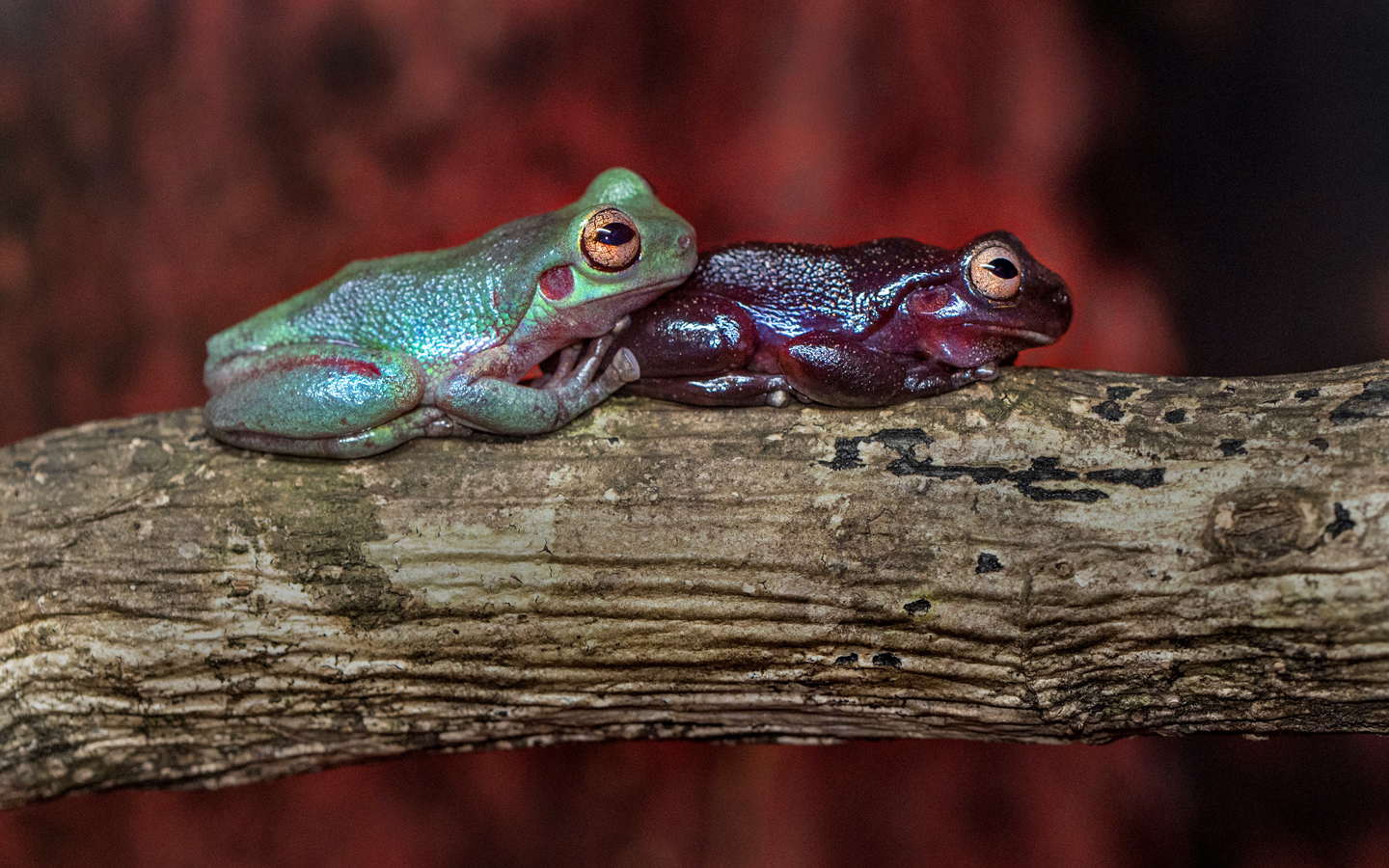
The cave-dwelling tree frog, Litoria cavernicola. Photo: David Clode, Unsplash.
'Devastating': The Morrison government cuts uni funding for environment courses by almost 30%
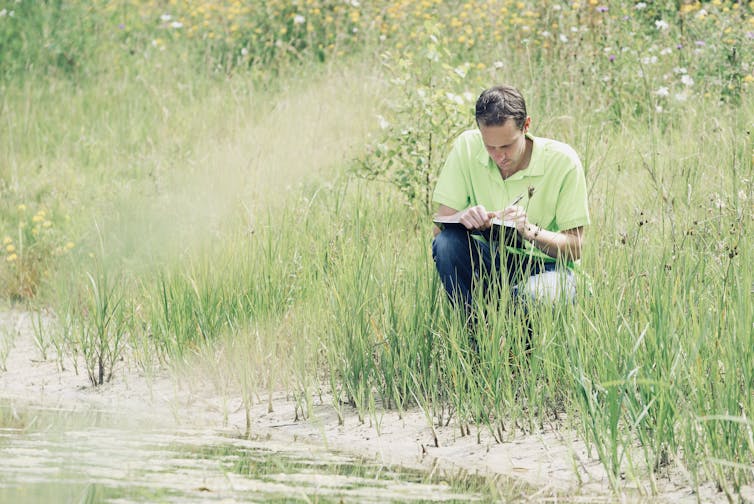
There has been much attention on how the Morrison government’s university funding reforms will increase the cost of humanities degrees. But another devastating change has passed almost unnoticed: a 29% cut to funding to environmental studies courses. This is one of the largest funding cuts to any university course.
Universities will receive almost A$10,000 less funding per year for each student undertaking environmental studies. The cut will undoubtedly lead to fewer students and lower-quality learning experiences.
Environmental studies encompasses the biological and earth sciences, as well as management and planning. Graduates go on to work as government policy officers, and managers in fields including water resources, the environment, urban planning and climate change adaption.
We are senior members of the Australian Council of Environmental Deans and Directors, with more than 80 years of collective experience in various environmental fields. At a time of unprecedented pressures on our environment, expertise in these fields is clearly needed more than ever.

Clear-Felling Environmental Expertise
The government’s Job-ready Graduates package applies to future students from 2021. It will cut the student contribution for environmental studies from A$9,698 to A$7,700 a year, and reduce the Commonwealth contribution from A$24,446 to A$16,500 per year. The move has been widely questioned.
We welcome any reduced fees for students. However the government contribution was not raised to cover the shortfall, so overall, the changes represent a cut of A$9,944 per year per student – a 29% decrease on current levels.
Currently, environmental studies funding is spent on specialised facilities such as labs equipped with cutting-edge technologies and field centres to support both teaching and research. It’s also spent on supporting students to gain practical and industry experience. This ensures world-class graduates skilled in the latest techniques and technologies.
More than 5,000 Australian students are currently enrolled in undergraduate environmental studies courses. While current students will not be affected by the changes, the enrolment number may drop in future due to fewer places being offered.
The funding cuts may also lower the quality of experiences offered to students or require cross-subsidisation. Some universities may also deem environmental studies courses unviable, and close them, while prioritising higher revenue-generating courses.
The change may also likely to lead to fewer staff, with specialist expertise in areas such as geospatial science, water chemistry and fire management. This will lead to smaller teaching teams with less expertise, who will in turn face increased teaching loads and less time for quality research.
Until now, Australia has been a world leader in training the next generation of environmental managers and scientists. Thirty of our universities have recently been rated as producing research in environmental science significantly above world standard. And environmental science at four Australian universities – Australian National University, University of Melbourne, UNSW and University of Sydney – was recently ranked in the top 50 worldwide.
Without adequate funding, this global standing is threatened.
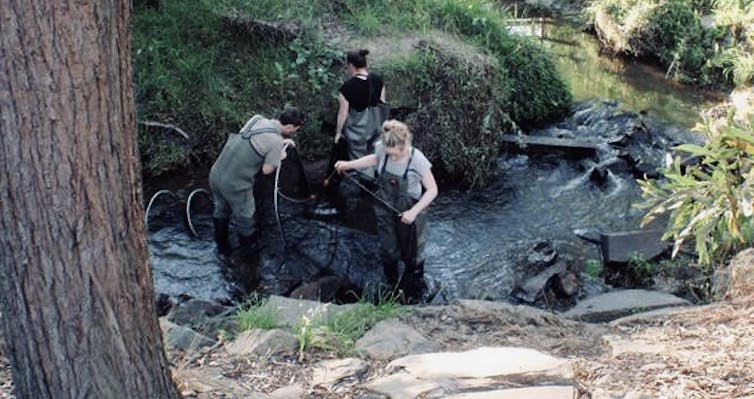
The Bigger Picture
Fewer and less well-trained environmental studies students will inevitably have a knock-on effect in sectors and industries that need quality graduates with specialist environmental knowledge, such as:
local, state and federal government, to ensure developments are sustainable and broadly benefit communities
agriculture, to address threats as diverse as water quality in the Great Barrier Reef, better retention of nitrogen fertilisers in soils and adaptation to climate change
mining, for advice on site planning and restoration to ensure minimal environmental harm during and after the mine’s operation
water management in rivers and wetlands, to respond to climate change and higher demand from growing populations.
What’s more, environmental studies courses – either as double degrees or core courses – are often part of other degrees such as law, journalism, teacher education, and engineering. This provides these professions with a critical understanding of the environment and sustainable management.
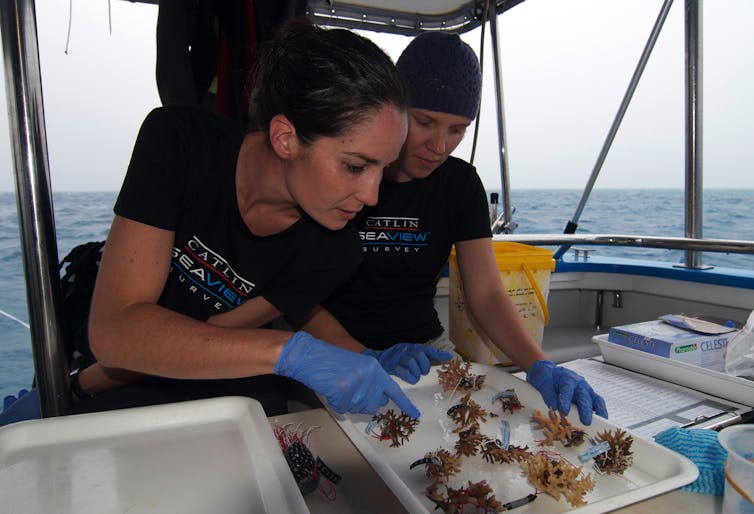
We Need Environmental Experts
Australia’s recent, brutal experience with bushfires and drought shows just how badly we need world-class environmental expertise. As climate change grows ever worse, these experts will be critical in steering us through these challenges.
What’s more, the COVID-19 pandemic – linked to land clearing and more human-wildlife interaction – shows just what can happen under poor environmental management.
Australia is uniquely vulnerable to climate change, and in 2019, recorded its worst-ever environmental conditions. These university funding cuts affect the people with the answers to our pressing environmental problems – they are a blow to the future of all Australians.
Read more: A major scorecard gives the health of Australia's environment less than 1 out of 10 ![]()
Dianne Gleeson, Professor, Science, University of Canberra; Ian Clark, Associate professor, University of South Australia, and Stuart Parsons, Professor, Queensland University of Technology
This article is republished from The Conversation under a Creative Commons license. Read the original article.
Can a mining state be pro-heritage? Vital steps to avoid another Juukan Gorge
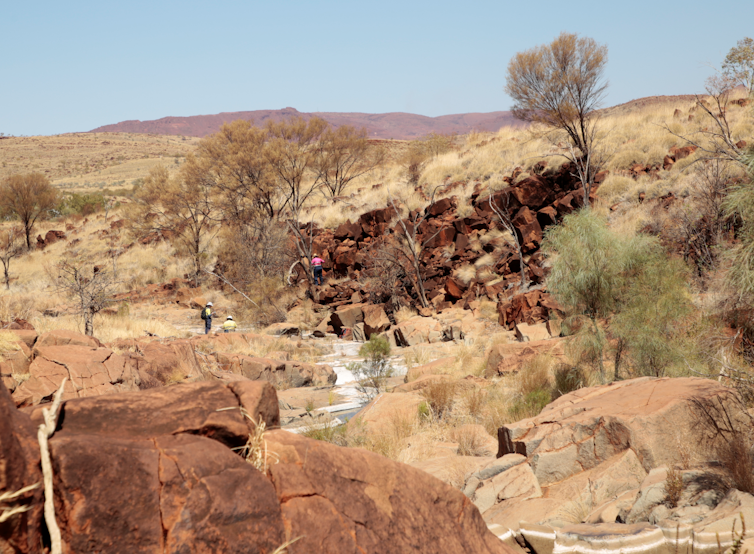
The destruction of 46,000-year-old Juukan Gorge sites in the Pilbara has created great distress for their traditional owners, seismic shockwaves for heritage professionals and appalled the general public.
The fallout for Rio Tinto has been profound as has the groundswell of criticism of Western Australia’s outdated heritage laws. A path forward must ensure a pivotal role for Indigenous communities and secure Keeping Places for heritage items. More broadly, we need more Indigenous places added to the National Heritage List, ensuring them the highest form of heritage protection.
In a state heavily dependent on mining, the model for this could follow the successful seven-year heritage collaboration I have been part of on-country with Murujuga Aboriginal Corporation (MAC) and Rio Tinto in the Dampier Archipelago (Murujuga).
As Director of the Centre for Rock Art Research and Management at the University of Western Australia, I am funded to undertake research supported by Rio Tinto’s conservation agreement with the Commonwealth.
This Rio Tinto funding enables research documenting the significant scientific and community values of the archipelago, feeding into the management of this estate by MAC, who represent the local coastal Pilbara groups. It also resources Indigenous rangers and trains undergraduate students.
The Murujuga conservation agreements, made between the Commonwealth and both Rio Tinto and Woodside, were negotiated when the archipelago’s one million-plus engravings and stone features were added to Australia’s National Heritage List in 2007.
Read more: Explainer: why the rock art of Murujuga deserves World Heritage status
Murujuga is one of only seven Indigenous rock art places on the National Heritage List. There are 118 listings in total in Australia (only 20 of them Indigenous). Murujuga is the only listed Indigenous site here with a conservation agreement requiring industry to fund heritage protection.
Rio Tinto does not have a similar agreement with the traditional owners of Juukan Gorge, the Puutu Kunti Kurruma Pinikuru (PKKP) peoples — nor do any of the other Pilbara resource extraction companies with their host native title communities. These mining tenements are managed by a range of royalty agreements, which recognise native title rights but are flexible and require transparency.
Despite working closely with Rio Tinto, I have been dismayed by the Juukan incident and the fault lines it has revealed in Rio Tinto’s historically significant investment in heritage management and agreement-making with Aboriginal people.
PKKP this week expressed their distress at the company’s behavior. Clearly, there is much for Rio Tinto to improve. But similarly, the regulation process is seriously flawed.
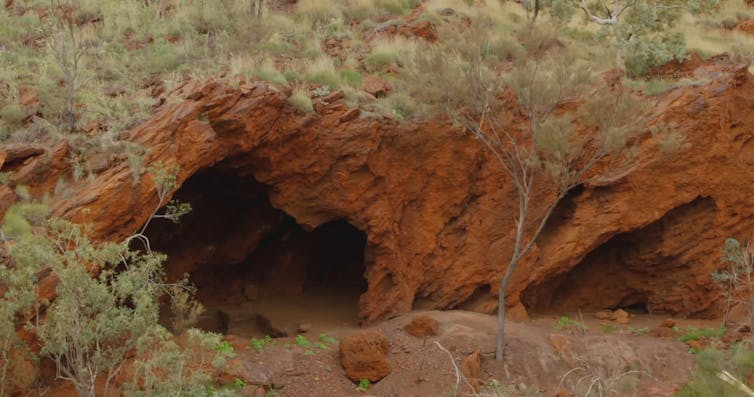
Read more: Rio Tinto just blasted away an ancient Aboriginal site. Here’s why that was allowed
Conserving Aboriginal Heritage
Many of the changes in the WA Government’s new Aboriginal Cultural Heritage Bill 2020 are welcome: in particular, the recognition of native title, allowing “stop work orders” if an Indigenous community says mining work was begun without their permission, and increased penalties for damaging heritage.
But Aboriginal groups, including many in the Kimberley and south-west WA, fear the onus for this regulatory process will be passed onto them and — despite being the appropriate people to manage their own heritage — they will not be adequately resourced to do so.
The number of heritage sites likely to be at risk in the future will number in the thousands, given the current footprint of mining is a mere 1% of the planned expansion over the next century. A new paradigm is needed in managing heritage. There needs to be a process of identifying regionally significant landscapes and earmarking them for conservation before future development footprints are determined.
And there need to be more conservation agreements like the Murujuga one, with industry-funding heritage and conservation rather than just mining clearance work.
In the Pilbara, for instance, there are three national parks, Karajini, Millstream-Chichester and Murujuga, where mining cannot occur. But more are needed in other native title areas. They need to be resourced so Aboriginal heritage rangers can manage them, with appropriate facilities for tourists.
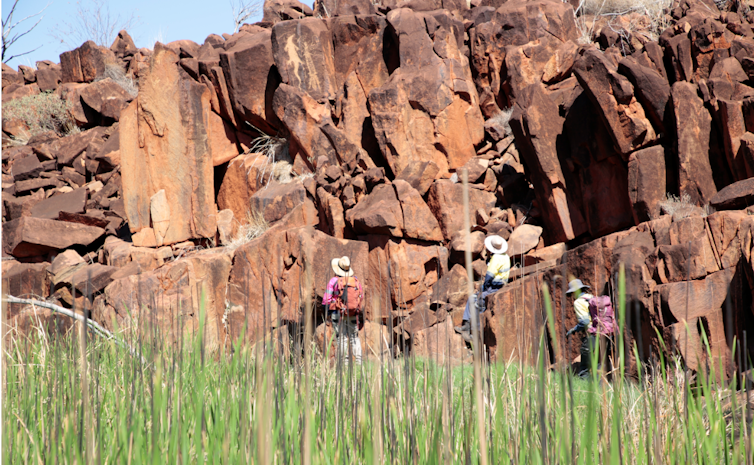
Mining compliance surveys, which “manage harm” to heritage are a significant economy for many Aboriginal communities.
But a number of Pilbara Aboriginal Corporations, including Wintawari Gurama, with whom I have developed a rock art research project, don’t want to just participate in the mining economy, which is tantamount to destroying their heritage.
They want to train local rangers, and document, record and manage their own heritage estates, enabling elders and young people to earn a living on country.
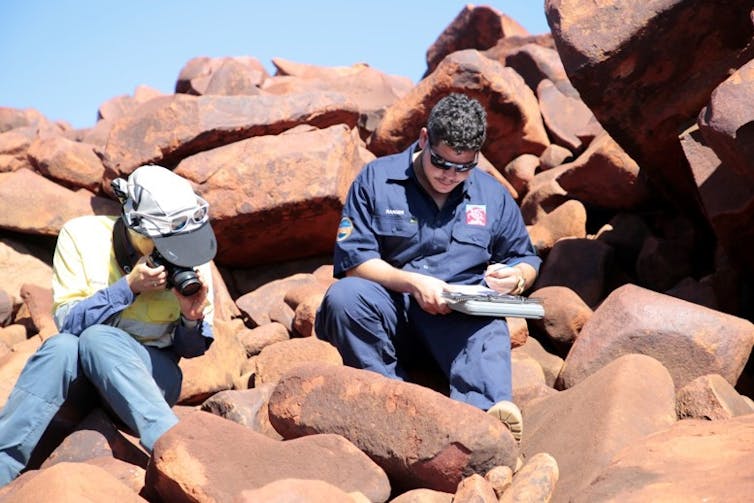
This approach is equally required in places like the Kimberley, where fracking could be the next resources “boom”.
Aboriginal Communities Need Keeping Places.
Across the Pilbara, items such as the 7,000 heritage items salvaged from Juukan Gorge, are being housed in locked shipping containers. Secure air-conditioned Keeping Places are an urgent requirement.
These, too, could be funded by industry, becoming the focus of heritage tourism and ranger training, and hosting collaborative research on heritage, biodiversity and conservation.
Murujuga, which has been added to the World Heritage Tentative List, has a tourism management plan. A Living Knowledge Centre is planned, and additional interpretation facilities.
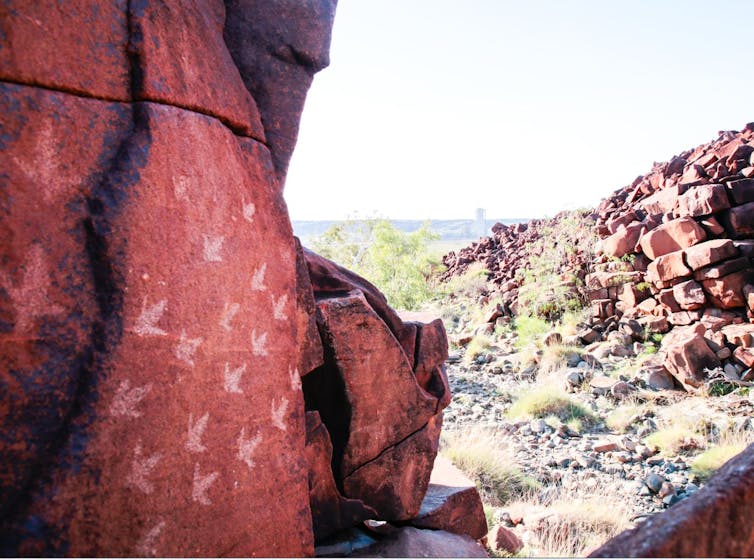
The state government and industry stakeholders are funding the Murujuga Rock Art Strategy, which will monitor and assess emissions from nearby industry. There are, however, concerning plans to introduce new industry in the adjacent Burrup Industrial Estate. This is an issue, too, for the federal government, which has ultimate oversight of heritage on the national list.
In WA, the state government asserts that heritage can co-exist with industry. But this will only be possible if the state recognises heritage is non-renewable — just like the mineral wealth of this country.![]()
Jo McDonald, Director, Centre for Rock Art Research + Management, University of Western Australia
This article is republished from The Conversation under a Creative Commons license. Read the original article.
Tick Population Booming In Our Area
Residents from Terrey Hills and Belrose to Narrabeen and Palm Beach report a high number of ticks are still present in the landscape. Local Veterinarians are stating there has not been the usual break from ticks so far and each day they’re still getting cases, especially in treating family dogs.
To help protect yourself and your family, you should:
- Use a chemical repellent with DEET, permethrin or picaridin.
- Wear light-colored protective clothing.
- Tuck pant legs into socks.
- Avoid tick-infested areas.
- Check yourself, your children, and your pets daily for ticks and carefully remove any ticks using a freezing agent.
- If you have a reaction, contact your GP for advice.
 Shorebird Identification Booklet
Shorebird Identification Booklet
The Migratory Shorebird Program has just released the third edition of its hugely popular Shorebird Identification Booklet. The team has thoroughly revised and updated this pocket-sized companion for all shorebird counters and interested birders, with lots of useful information on our most common shorebirds, key identification features, sighting distribution maps and short articles on some of BirdLife’s shorebird activities.
The booklet can be downloaded here in PDF file format: http://www.birdlife.org.au/documents/Shorebird_ID_Booklet_V3.pdf
Paper copies can be ordered as well, see http://www.birdlife.org.au/projects/shorebirds-2020/counter-resources for details.
Download BirdLife Australia's children’s education kit to help them learn more about our wading birdlife
Shorebirds are a group of wading birds that can be found feeding on swamps, tidal mudflats, estuaries, beaches and open country. For many people, shorebirds are just those brown birds feeding a long way out on the mud but they are actually a remarkably diverse collection of birds including stilts, sandpipers, snipe, curlews, godwits, plovers and oystercatchers. Each species is superbly adapted to suit its preferred habitat. The Red-necked Stint is as small as a sparrow, with relatively short legs and bill that it pecks food from the surface of the mud with, whereas the Eastern Curlew is over two feet long with a exceptionally long legs and a massively curved beak that it thrusts deep down into the mud to pull out crabs, worms and other creatures hidden below the surface.
Some shorebirds are fairly drab in plumage, especially when they are visiting Australia in their non-breeding season, but when they migrate to their Arctic nesting grounds, they develop a vibrant flush of bright colours to attract a mate. We have 37 types of shorebirds that annually migrate to Australia on some of the most lengthy and arduous journeys in the animal kingdom, but there are also 18 shorebirds that call Australia home all year round.
What all our shorebirds have in common—be they large or small, seasoned traveller or homebody, brightly coloured or in muted tones—is that each species needs adequate safe areas where they can successfully feed and breed.
The National Shorebird Monitoring Program is managed and supported by BirdLife Australia.
This project is supported by Glenelg Hopkins Catchment Management Authority and Hunter Local Land Services through funding from the Australian Government’s National Landcare Program. Funding from Helen Macpherson Smith Trust and Port Phillip Bay Fund is acknowledged.
The National Shorebird Monitoring Program is made possible with the help of over 1,600 volunteers working in coastal and inland habitats all over Australia.
The National Shorebird Monitoring program (started as the Shorebirds 2020 project initiated to re-invigorate monitoring around Australia) is raising awareness of how incredible shorebirds are, and actively engaging the community to participate in gathering information needed to conserve shorebirds.
In the short term, the destruction of tidal ecosystems will need to be stopped, and our program is designed to strengthen the case for protecting these important habitats.
In the long term, there will be a need to mitigate against the likely effects of climate change on a species that travels across the entire range of latitudes where impacts are likely.
The identification and protection of critical areas for shorebirds will need to continue in order to guard against the potential threats associated with habitats in close proximity to nearly half the human population.
Here in Australia, the place where these birds grow up and spend most of their lives, continued monitoring is necessary to inform the best management practice to maintain shorebird populations.
BirdLife Australia believe that we can help secure a brighter future for these remarkable birds by educating stakeholders, gathering information on how and why shorebird populations are changing, and working to grow the community of people who care about shorebirds.
To find out more visit: http://www.birdlife.org.au/projects/shorebirds-2020/shorebirds-2020-program
Pittwater Reserves
Aussie Bread Tags Collection Points

Nutrition Key To Health For Senior Australians
What Keeps You Awake At Night?
- Do you have excessive daytime sleepiness?
- Loud snoring, snorting and gasping at night?
- Dry mouth with morning headaches?
- Poor concentration, memory problems and irritability?
Waiting Lists Point To Post-Covid Hospital Crisis: AMA Public Hospital Report Card 2020
- providing adequate funding to cover the predicted increase in demand for public hospital services,
- recognising the impact of COVID-19 on State Government budgets and the limits on their ability to fund growth in public hospital services,
- acting immediately to address the ongoing fall in private health insurance membership to preserve the capacity of the public hospital system to provide care to those who need it most,
- supporting general practice to deliver high quality primary and preventive care in order to prevent avoidable hospital admissions.
- In 2018-19, more than 8.3 million patients presented to public hospital emergency departments – a 4.2 per cent increase on the previous year.
- More than three million emergency patients were categorised as Urgent– requiring treatment within 30 minutes – but more than one in three waited for longer than clinically recommended.
- Urgent patients were less likely to be treated within 30 minutes in 2018-19 than they were in 2013-14.
- In 2018-19, only one in two patients (53 per cent) who needed resuscitation left emergency within four hours.
- The total number of available public hospital beds in Australia in 2017-18 dropped by 122 below 2016-17 levels. Public hospital bed ratios per 1,000 population for the high utilization cohort aged over 65 years declined in 2017-18 for the 26th consecutive year to 16.0 – the lowest level since 1991-92.
- The national median wait time for all elective surgery in 2018-19 was 41 days – the worst performance since 2001-02.
Budget Allocations For The Hard Of Hearing
- $5 million hearing health awareness campaign
- $7.3 million for research to develop a sound evidence base for effective treatment, service delivery, and prevention of hearing loss
- $5 million for improvements in and early identification of hearing and speech difficulties for Aboriginal and Torres Strait Islander children
- $2 million for initiatives in the aged care sector to improve the capability of the aged care workforce to support people with hearing loss.
- $400,000 for development and adoption of new tele audiology standards for hearing services.
- $200,000 to support rural service delivery through a workforce audit and a rural hearing workforce summit.
Celebs Wish Class Of 2020 ‘Good Luck’
From football stars to musicians and actors, Australian celebrities are putting their star power behind our HSC students.
With HSC written exams set to commence in a few days away, some of our best known Australians have sent their good luck messages to the Class of 2020.
Education Minister Sarah Mitchell said that 2020 had thrown up plenty of challenges and our HSC students had met them with the help of their school, family and friends.
Now the broader community wanted students to know they had got this.
“This is about reminding students that as they take on the final chapter of the HSC, all of NSW is behind them. From today students will hear from actors, TV personalities, local musicians and sporting stars,” Ms Mitchell said.
“Some will share their tips and advice for staying healthy and focused, while others share how they have overcome adversity – all with the aim of letting students know they can do this.
“With the start of written exams only days away, my message to students is to continue to take care of your wellbeing, reach out for support or advice if you need it and keep active. We are all behind you.”
Messages of support
“Enjoy this milestone, look around and remember there’s a team of people, your family, your friends, your teachers who have got you to this point.” – Sally Fitzgibbons, World #1 Australian professional surfer.
“Good luck to all you amazing students of 2020. Go get 'em!” – Claudia Karvan, Australian actress, producer and scriptwriter.
“I wish you all nothing but the best for the future, sending you lots of love.” – Australian fashion model, Samantha Harris.
Hear from the stars getting behind the Class of 2020 on Twitter and Facebook, visit the Stay Healthy HSC hub for tips and advice for students and their families.
Surfing NSW Launches New Creative Kids Program
Tuesday 13 October 2020
Surfing NSW is pleased to announce the launch of the Surfing NSW Creative Kids program.
The program is a new six-week course where participants will learn the basics of surf photography, filming and content creation as well as tips to build a portfolio and get their work seen.
The program will develop a creative skillset for high-school-aged participants through a series of online modules.
All classes are covered by the $100 Creative Kids voucher (available to download from Service NSW). In addition, all participants will receive a prize pack from our sponsors Havaianas, discounts on equipment from AquaTech as well as money-can’t-buy experiences with some of the most renowned photographers and filmers in surfing.
Over the course of the program, Surfing NSW will aim to provide all students with skills that they will be able to grow and use to best capture their love of the ocean and showcase each of their unique perspectives.
Surfing NSW CEO Luke Madden is elated to get the Surfing NSW Creative Kids program up-and-running.
“The Surfing NSW Creative Kids program is an initiative that I’m extremely passionate about and I believe that budding photographers and hobbyists will be able to learn a lot about how they can create decent imagery and film pieces.”
The first module in the Surfing NSW Creative Kids is ready to be watched right now and modules continue to drop every week over the next six weeks.
Participants can join any time and are free to binge-watch all six episodes at their convenience.
For more information on the Surfing NSW Creative Kids please check out surfingnswcreativekids.com or email creativekids@surfingnsw.com.au
The Surfing NSW Creative Kids program is supported by Havaianas, AquaTech, Australian Skin Cancer Clinics, Service NSW and Surfing NSW.
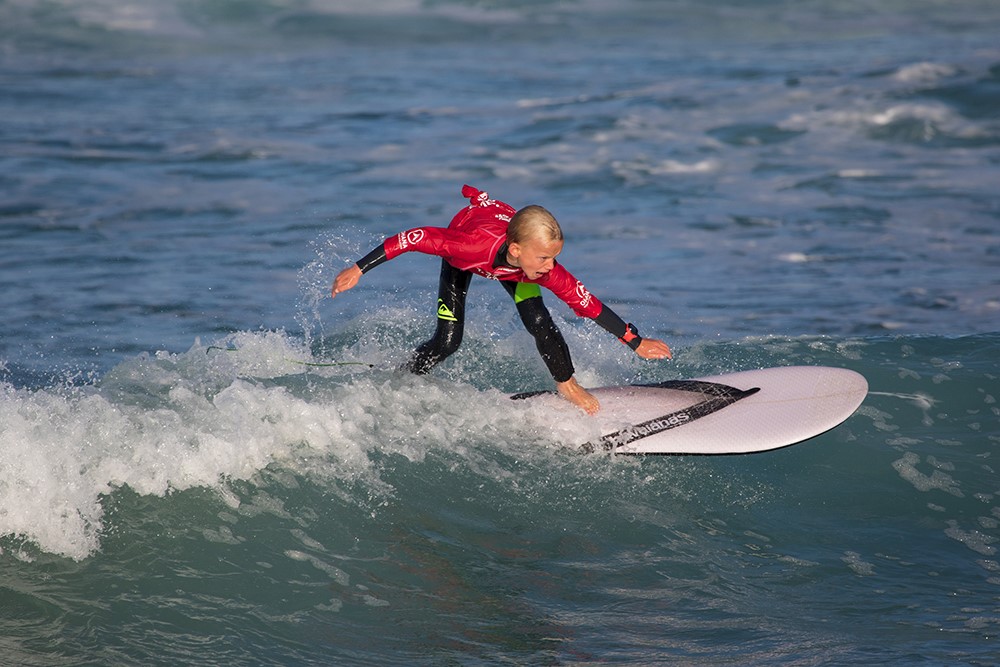
Photo: Ethan Smith / Surfing NSW
Waves Of Wellness
Waves of Wellness offer free weekly learn-to-surf lessons that are paired with wellness discussions on the beach. It's for men aged 16+ and is launching again in Warriewood later this month (October 30, 2020). Many people have greatly benefited from this program, so if you know of anyone who could gain from it, get them to register here: https://www.wowsandnsurf.com/
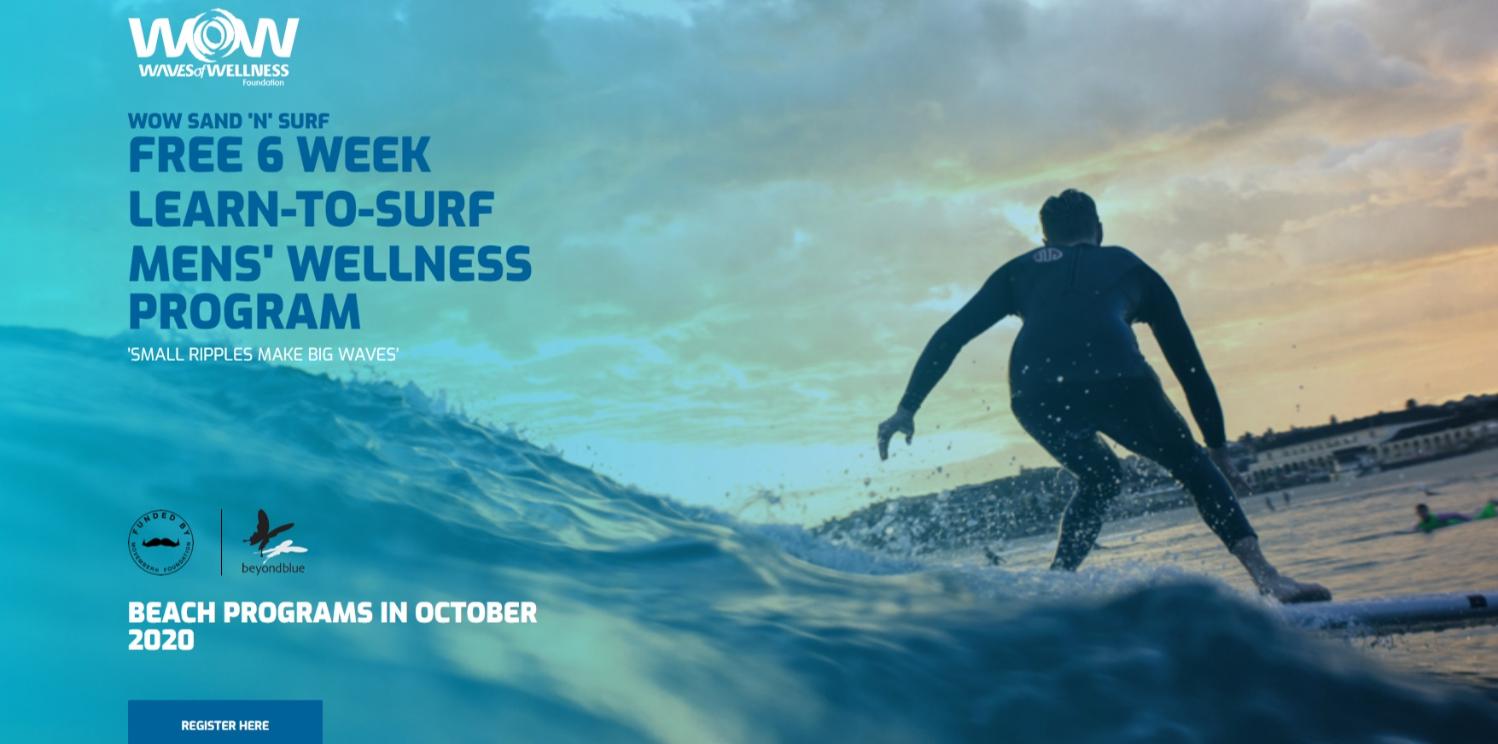
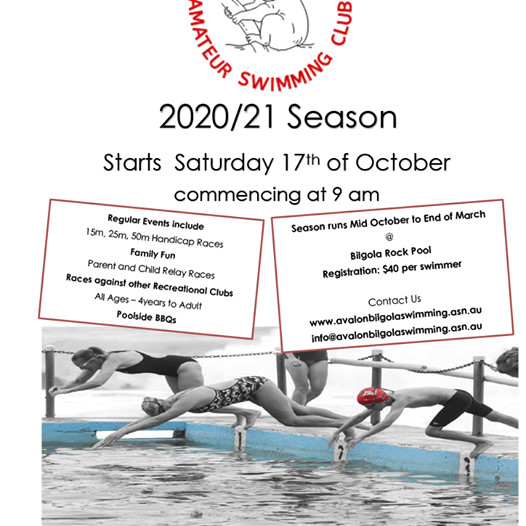
Avalon Bilgola Amateur Swimming Club 2020/2021 Season
Aussie Back Yard Bird Count 2020
How to get involved
The Aussie Bird Count is a great way to connect with the birds in your backyard no matter where your backyard happens to be — a suburban backyard, a local park, a patch of forest, down by the beach, or the main street of town.
You can count as many times as you like over the week, we just ask that each count is completed over a 20-minute period. The data collected assists BirdLife Australia in understanding more about the birds that live where people live.
Register here: https://aussiebirdcount.org.au

New Look SAILING Champions League: Asia Pacific 2021 Season
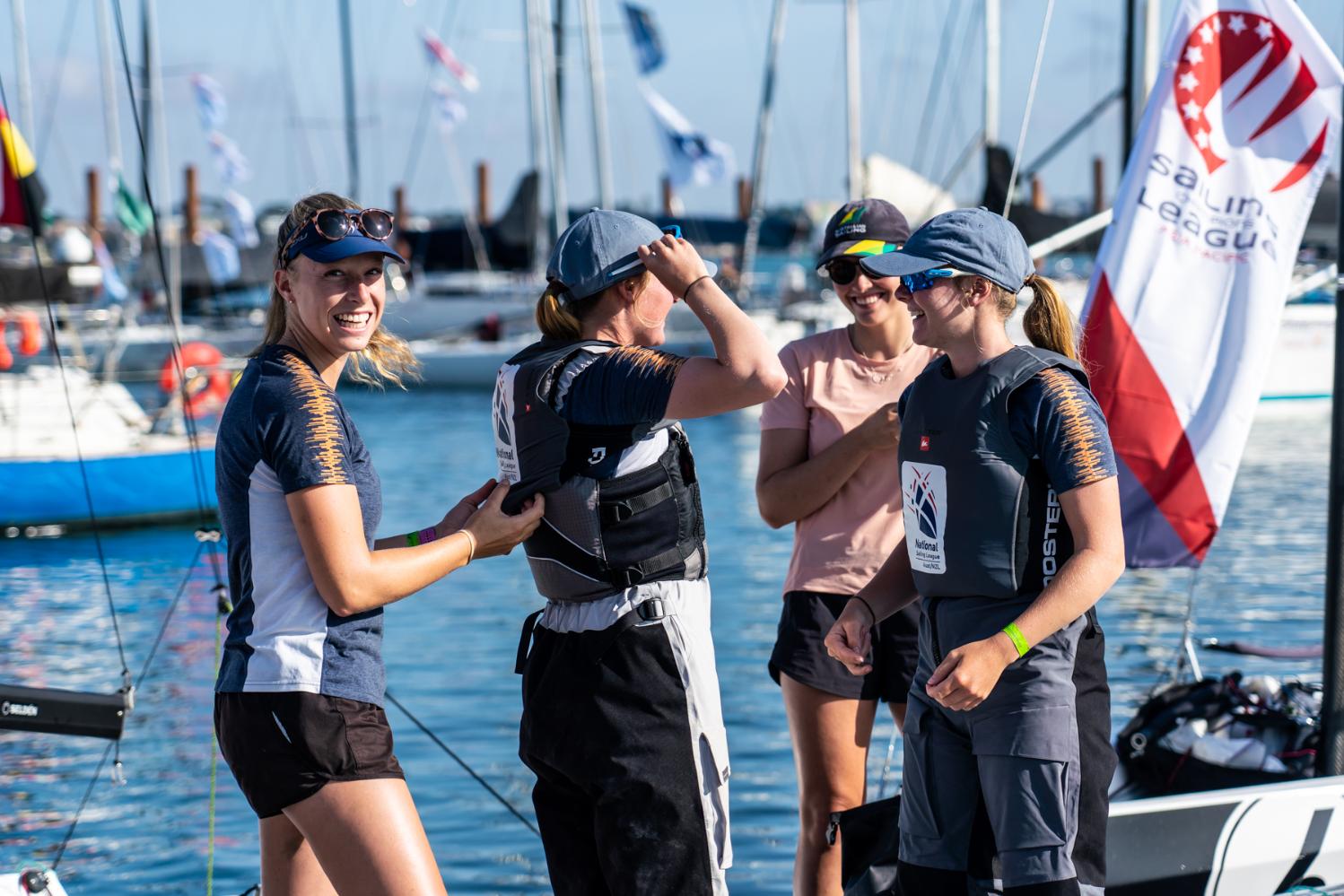
Asia Pacific organisers are delighted to announce the 2021 season format and a raft of changes to simplify the competition and bring gender equity to the league.
For next year’s schedule of racing on supplied RS21 keelboats there will be two divisions only – Open and Youth (under 22) and all teams must be 50/50 female and male, with a maximum four crew per boat.
Asia Pacific League director Mark Turnbull says, “For our third season we will implement gender parity based on our own views plus World Sailing’s findings and recommendations from their Women in Sailing Strategic View conducted in 2019. We see teams of two male and two females representing their clubs as the way forward, which will again deliver great racing and simply make for better events.”
The 2021 circuit will include two qualifying regattas - Southern and Northern - at great venues with dates and details plus the Notice of Race available shortly. Qualifiers will culminate in a new ‘Finals Week’ concept on Sydney Harbour, from April 13-17, 2021 at a location where the public can spectate and engage with the sailors. “This fulfils the international league’s goal to host grandstand-style high-rotation races close to shore, making the sport more accessible,” Turnbull says.
Geelong, home of the Festival of Sails’ sailing extravaganza over the Australia Day long weekend, will host the opening qualifier in January 2021 for southern clubs, from Victoria, Tasmania, South Australia and Western Australia.
The Northern Qualifier, on Sydney Harbour in March will be open to entries from the ACT, New South Wales, Queensland and the Northern Territory.
Dates for the Southern and Northern Qualifier will be confirmed shortly via https://sailing-championsleague.asia/ and the league’s social media channels.
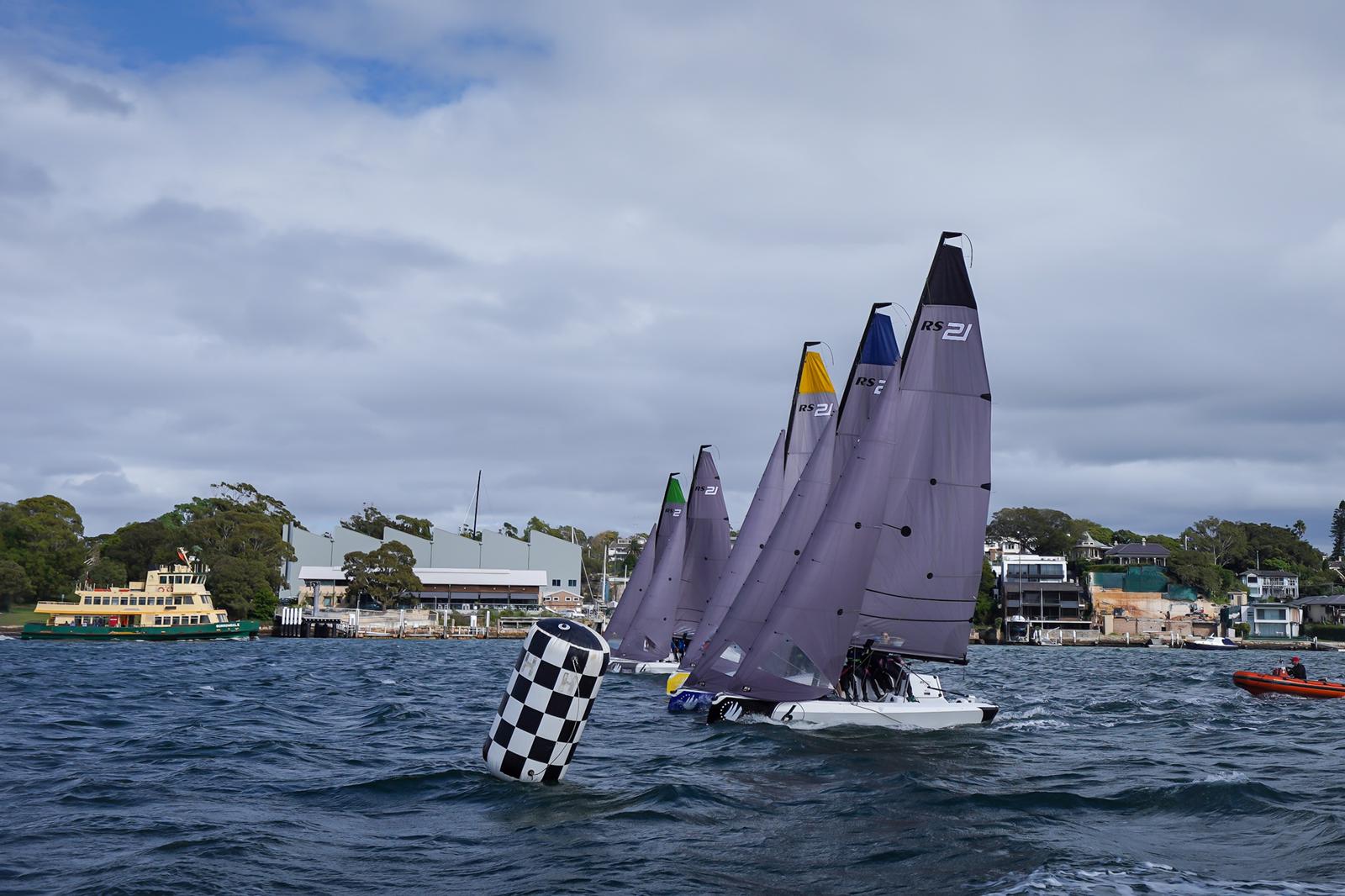
2020 SCL Northern Qualifier start off Woolwich - photo by Beau Outteridge
In the 2021 April school holidays, Sydney Harbour will be the spectacular backdrop for the SAILING Champions League: Asia Pacific Finals Week. The Youth Final (U22), to be held on April 13-14, will lead into the ultimate Open Final at the same venue across April 15-17. This format allows the U22 teams to compete in the Open Final.
The top eight qualifying Australian crews from both the Southern and Northern Qualifier (U22 and Open) will meet up with eight invited clubs from Asia and the Pacific at Finals Week, to determine the Asia Pacific U22 and Open champions. From these Asia Pacific Finals the top Australian, top Asian and top Pacific teams in U22, Women’s and Open qualify to represent their club at the 2021 SAILING Champions League: World Finals in Europe.
Turnbull adds, “While we eagerly await the start of our summer sailing season and the 2021 league events, I encourage people to tune in live to the 2020 SAILING Champions League - Final in Europe, between October 15-18. Details at sailing-championsleague.com.
“Due to coronavirus and the cancellation of most of this year’s Asia Pacific events, sadly we aren’t represented among the Final line-up, and miss out on the chance to defend the region’s 2019 win at St Moritz, thanks to a brilliant effort by the Royal Sydney Yacht Squadron’s team. We are optimistic the 2021 SAILING Champions League: Asia Pacific season can proceed as scheduled and we will be back on the world stage next year,” said Turnbull.
“Standby for 2021 event locations, dates and Notices of Race, but in the meantime start thinking about your team of four and encourage your club to get behind the concept of ‘rock-up and race’, club versus club competition on new one design keelboats.”
For you or your club to be a part of the SAILING Champions League: Asia Pacific register your interest directly by contacting mark@nationalsailingleague.com.au.
Northern Qualifier video wrap-up thanks to Beau Outteridge.
By Lisa Ratcliff
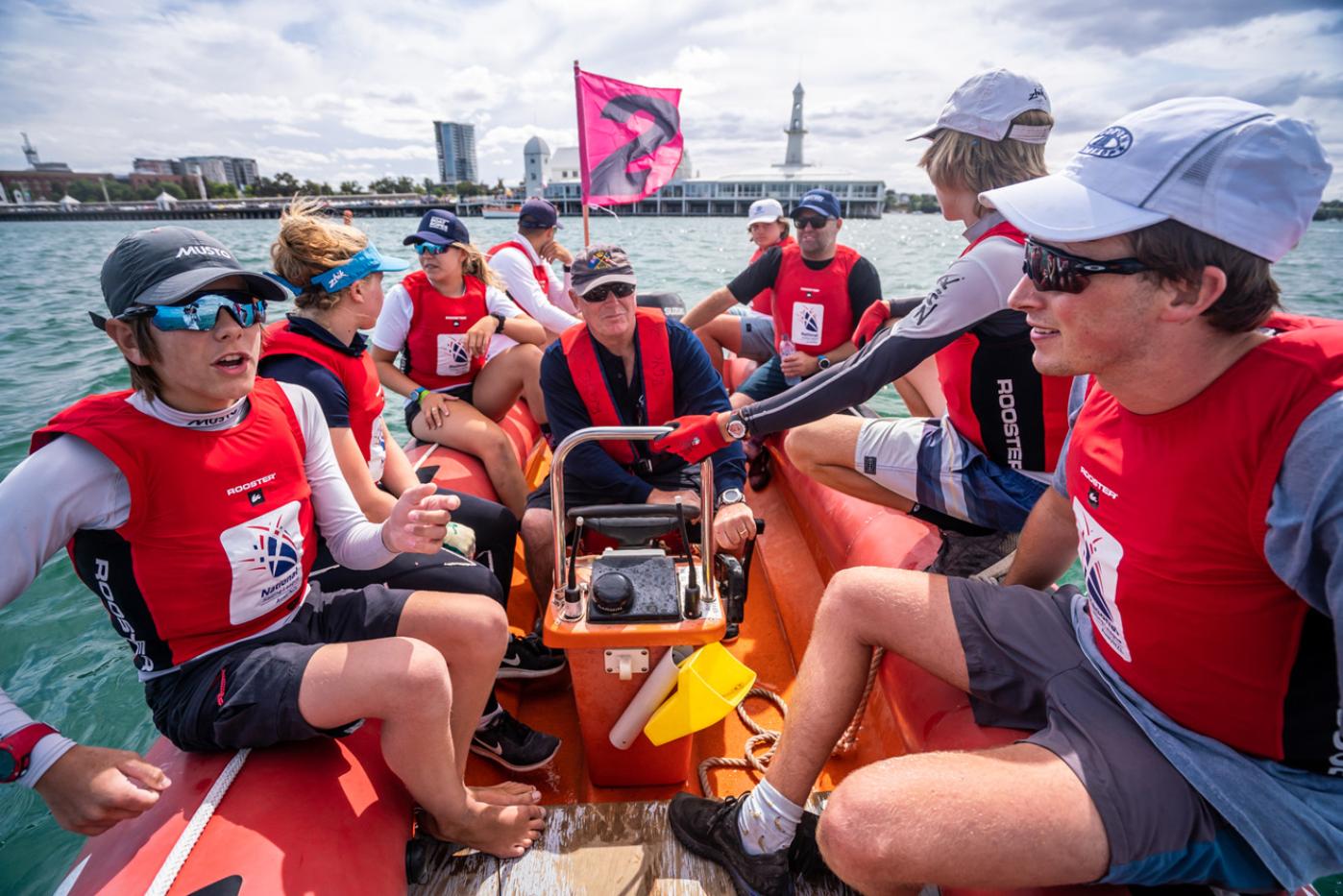
Friday essay: crafting a link to deep time from ancient river red gum
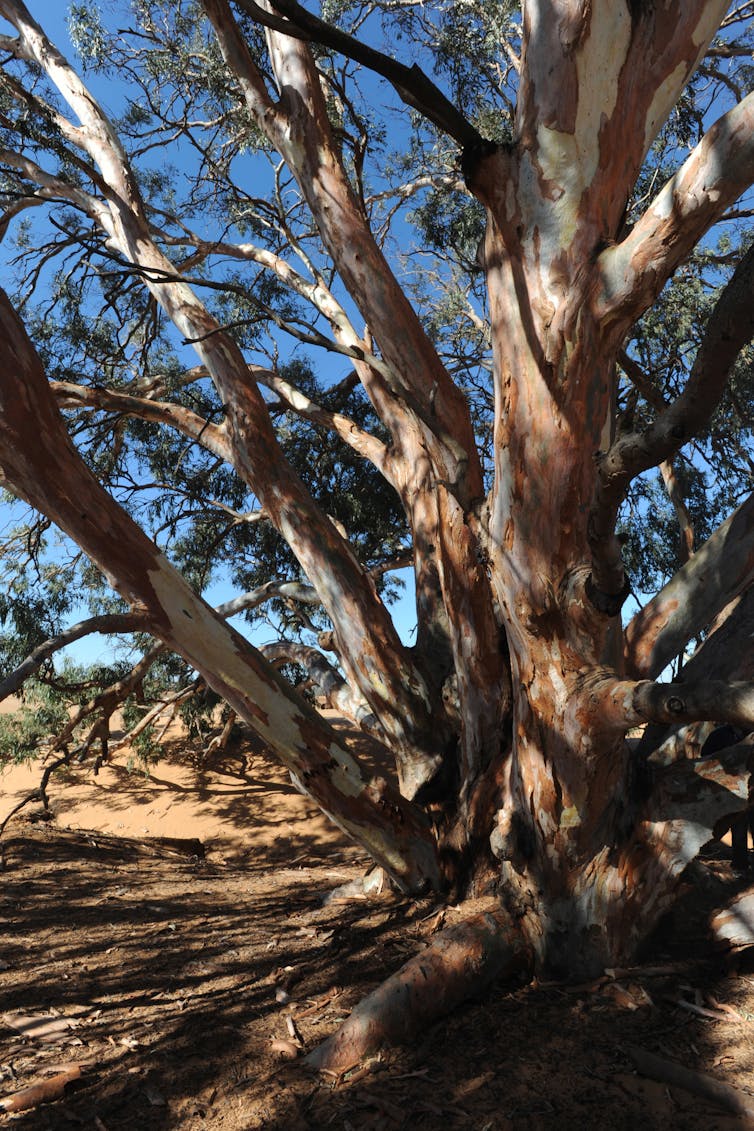
With a mischievous smile, Damien Wright gives the exhibit an unceremonious kick. The enormous, curved slab of river red gum rocks back and forth on the gallery floor, casting a wavering shadow over the “Do Not Touch” sign at its base.
A couple of anxious visitors shuffle over to investigate as Damien tells me how he made this wobbling wooden bowl, and why he chooses to work with the hardest, most challenging timbers.

The river red gum (Eucalyptus camaldulensis) once grew on the banks of the Murray River. Damien discovered the thick slab in a miller’s yard in Wodonga, where it had lain exposed to the elements for years, slowly warping in the heat. What others had dismissed as damaged wood, Damien saw as creative possibility: he relished the opportunity to work with wood that had been “cooked, cured and crazed by the sun”.
In his workshop in Northcote, Melbourne, he worked to accentuate the warp in the wood by curving the edges of the slab, creating a long, bowing channel, almost three metres in length and over a metre wide. Like all his work, this object is an argument he has made with his hands.
The rough, red, cracking grain of the wood runs lengthways across the piece, like gullies and rivulets spreading across a parched, burnt land. Damien encourages this comparison with his title, which is a pointed commentary on the mistreatment of the waterways on which the tree grew.
“It’s called Food Bowl”, he tells me. And then, gesturing to a knot in the centre, “It drains in the middle”.
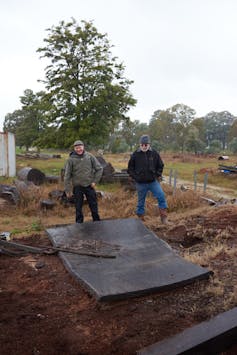
For Damien, wood is a way of thinking about place and time — even deep time. A river red gum may grow for anywhere between 400 and 1,000 years before it falls. And as it decomposes over centuries it becomes a home for new life. Murray cod lay their eggs in drowned red gums.
To work with wood is to think beyond a human lifespan. When you look at something like the Murray-Darling system from the perspective of a grand old red gum, you see the fragility and inter-connectedness of the waterway, and how rapidly it has degraded with recent human interventions.
“And if you have that conversation about deep time in this country”, says Damien, “you have to talk about Indigenous people and this continent as an occupied and cultural space, not just a physical place”.
Read more: Friday essay: when did Australia’s human history begin?
River red gums were a part of Australia’s environment long before people arrived here. They grew beside the Murray River when it was a wide, cold, fast-flowing stream; they witnessed its transformation in the late Pleistocene into a narrow, sinuous, seasonal river; and they have remained, over the past 13,000 years, as the water has slowed and warmed, forming swamps, low sand dunes and small lakes along the channel, and seasonal wetlands in the wider riverine plain.
These mighty trees have also been absorbed into the social and cultural worlds of Indigenous Australians. Their roots have been dug and hollowed out to create bowls, their bark cut to craft canoes, and their limbs burned to warm camps and cook food. In recent millennia, they presided over the most densely populated areas of the continent.
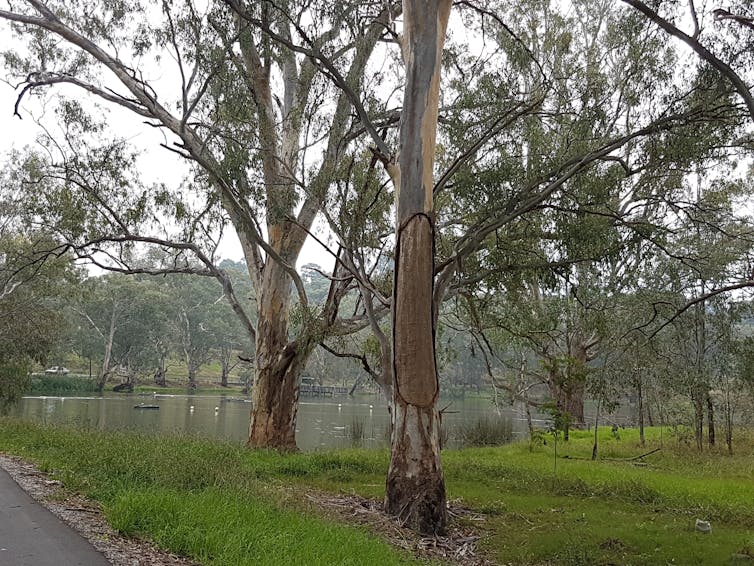
Read more: The ring trees of Victoria's Watti Watti people are an extraordinary part of our heritage
Damien tells me how he seeks to evoke this deep history through his craft as he shows me two of his other pieces: a striking lantern (Black Lighthouse) he made in collaboration with Yolngu craftsman Bonhula Yunupingu, which glows like a fire through thin, black wood; and an elegant reading chair and angular side table called Ned — a riff on Sidney Nolan’s Ned Kelly helmet, which it closely resembles.
Each piece of furniture has been made from red gum in a stage preliminary to fossilisation. The wood is black and almost as hard as stone. It is known as ancient red gum.
While other native timbers enable Damien to explore relationships with the Australian environment, the ancient red gum opens a conversation about deep time on this continent.
Geomorphologist Jim Bowler was the first to identify the material as red gum; he used radiocarbon dating to place its age at about 8,000 or perhaps 10,000 years old. Later I call him and, over the phone, he sketches out the wood’s journey from the banks of the Murray River to the workshops of inquisitive artisans like Damien.
The tree would have seeded after the end of the last ice age, at a time when sea levels were rising and the climate was warming.
The rapid snowmelt in the Victorian Alps caused the mountains to shed huge amounts of gravel, which was then swept into the Murray River. As red gums fell into an ancient channel they were covered by this new gravel, which sealed them in the riverbank.
Preserved from decay by the acidity of the water, the entombed wood slowly absorbed enormous amounts of iron and silica. This oxidising and ebonising process is what makes it black through to the centre and hard, much harder than other red gum.
Articulating A Future
Jim first became aware of the red gum when he received some samples at the Melbourne Museum in 1990. The damp and fibrous wood had been unearthed in a quarry on Yorta Yorta land in Wodonga, where it was regarded as a nuisance by those more interested in the gravel around it.
Jim and his wife Joan Bowler recognised the significance of the timber and were eager to see it preserved and used. They helped arrange for the director of the museum to provide “authentications” for woodworkers to make it into furniture, and Joan and her friend Annetine Forell travelled the country over the following two decades, drawing the remarkable material to the attention of millers and craftspeople.
The late Kelvin Barton, a miller, woodworker and seventh-generation farmer, became a crucial intermediary. He collected the ancient red gum in Wodonga, reducing its water content in his ersatz kiln to turn it into workable timber. This was how Damien, a long-term friend and collaborator, came to encounter the ancient red gum — indeed it was in Kelvin’s yard that he found the much younger slab that became Food Bowl.
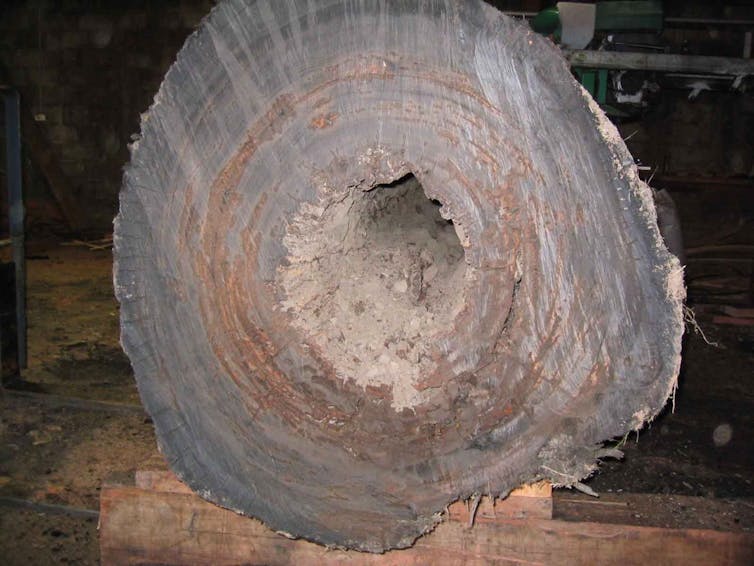
Damien uses the ancient red gum to articulate his vision for Australia. He sees craftsmanship as a language: a practice that is refined over time to communicate knowledge, beauty and ideas.
He considers his furniture — in its functionality as well as its elegance — as an embodiment of this philosophy. Objects tell stories. They become part of our everyday lives and express everyday futures:
My argument is that to take a material that is ten thousand years old and to articulate that in a beautiful and passionate way and to make that a relevant thing to our lives or to peoples’ lives is a way of articulating a future for this continent. It’s a way of understanding our place in time. It’s a way of dealing with people. It’s a way of projecting forward.
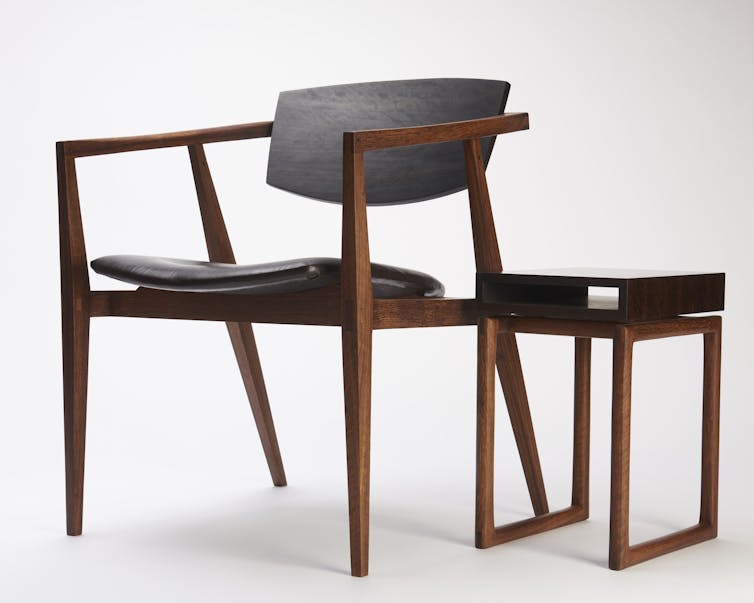
Joan Bowler shares this vision for the ancient timber. In 2008, her company Australian Ancient Redgum donated a six-metre “Fossil Tree” to the Children’s Garden at the Royal Botanic Gardens Victoria, so that “children can sit under this ancient tree and look up through the hollowed out centre and dream of what was and what might be”.
Trees that were seeded after the end of the last ice age, that survived the ruptures of invasion and industry, have reemerged to offer a deep-time perspective of the continent.
It is a scale that reveals the long-term costs of short-term exploitation, and renders processes like the degradation of the Murray-Darling river system into sudden events.
Ancient red gum also invites a longer view of Australian history. And in the hands of Joan and Damien, it calls for the acknowledgement of cultures and histories that for so long have gone unrecognised.
This is an extract from Living with the Anthropocene, Love, Loss and Hope in the Face of Environmental Crisis, edited by Cameron Muir, Kirsten Wehner & Jenny Newell (New South Books).![]()
Billy Griffiths, Lecturer, Deakin University
This article is republished from The Conversation under a Creative Commons license. Read the original article.
How toy pianos went from child's play into classical concert halls

A child’s toy may seem like an unlikely candidate for the classical concert hall. Around the world, however, thousands of musicians gather every year for festivals, conferences and concerts dedicated to the toy piano.
Exploring its sound, range, and playing technique, these composers and performers congregate to talk about latest developments in toy piano music and perform new pieces.
Along with many festivals in the US and Germany, Italy and Korea have both held their first toy piano festival in recent years.
Pop artists such as Bruno Mars and groups such as Coldplay have brought a larger audience to what was once considered a niche and experimental use of the instrument. Search “toy piano” or “tiny piano” on Twitter or Facebook and you’ll find countless posts featuring performers and composers using or discussing the instrument.
Read more: Jamming with your toddler: how music trumps reading for childhood development
Serious Music With A Playful Spin
Toy pianos, despite being designed and marketed to children and families, have been used for decades to write everything from concertos to pop songs.
French composer Yann Tiersen used one prominently in his score to the 2001 film Amélie to represent the title character’s inner child.
Neil Diamond’s song, Shilo, is one of the earliest pop songs to feature toy piano (you can hear it in the bridge at about the 2:28 mark here).
And John Cage’s 1940s suite for toy piano, where he took all the seriousness of writing for the piano and put a playful spin on it, came at a crucial moment in the mid-20th century; hard borders of the musical arts, which reached a limit of seriousness in the 1920s and 1930s, had started to break down.
This mixing of traditional “high music” with artefacts that might be considered juvenile, populist, naff, or domestic, was becoming more common — and more exciting.
Play And Experimentation
Toy pianos typically have a range of 12-36 keys, roughly one quarter the range of a full piano (though there are smaller and larger examples, too).
These acoustic instruments are made from a wood or plastic frame. They produce a bell-like sound when a small hammer hits a tube or flat piece of metal inside.
Unlike a typical piano, toy pianos are rarely tuned to perfection and can sound a bit off to the ear but many can’t help but be charmed by their tiny size, variety of colours and quirky inconsistent plonking.
With its history and connection to ideas of childhood, this instrument is commonly used to musically convey a sense of innocence and nostalgia.
Traditionally, art music composition can be very prescriptive and confined. The traditional conservatorium or university composition class teaches the rules of writing — what you can and cannot do with an instrument — but something about the toy piano invites play and experimentation.
Every Toy Piano Is Different
Unlike many instruments used for composing, the toy piano is not standardised around the world.
There are dozens of makers who use different techniques and different materials giving every toy piano a unique sound, range, and register. This makes writing music for the piano a bit random — but for many of us, therein lies the fun.
If you write a piece of music for the toy piano and if a performer in another part of the world has enough keys on their instrument, they can play your piece in their own special way. It’s like a singer using their own unique voice to cover a song.
The composer gives up some control, which contrasts sharply with romantic and and modernist-era ideas that positioned the composer as a genius whose works should never be altered.
Many composers end up collecting toy pianos, which gives them a variety of sounds to play with. Australian composer Elena Kats-Chernin became known as the toy piano lady at a Sydney toy store after buying eight in a row. I’m up to a modest five and am resisting buying my sixth.
Toy piano specialists are becoming more common as performers and composers in demand.
Italian specialist Antonietta Loffredo has performed several times in Australia and released many recordings with the Australian art music label Wirripang. You can hear her recordings of works by Australian composers on Spotify here.
Margaret Leng Tan, a toy instrument virtuoso with many commissions and dedications to her name, was due to perform with toy piano at the Sydney Opera House this year but the concert was postponed due to COVID-19.
As Margaret Leng Tan herself puts it:
I remain wholeheartedly intrigued by the toy piano’s magical overtones, hypnotic charm, and not least, its off-key poignancy. In the words of author John David Morley, “Sound combed from the keys of a stairway ascending faintly into sleep”. My composer-friends were similarly beguiled and driven to frenzied heights of creativity by this modest little instrument.
Escaping A Rigid World
Artists are always looking for new ways to challenge and surprise audiences. What is and isn’t accepted on the concert stage is constantly shifting and the rise of the toy piano suggests that we are ready to welcome new sounds and new instruments into the relatively closed world of classical music.
To many composers, the toy piano offers more than a symbolic representation of childhood — it provides an exciting escape from the strict and rigid world of formal contemporary art music.
Read more: From the First Fleet to Changi, Australia's pianos have a long history ![]()
Paul Smith, Senior Lecturer in Music, University of New England
This article is republished from The Conversation under a Creative Commons license. Read the original article.
Hidden women of history: Kyniska, the first female Olympian
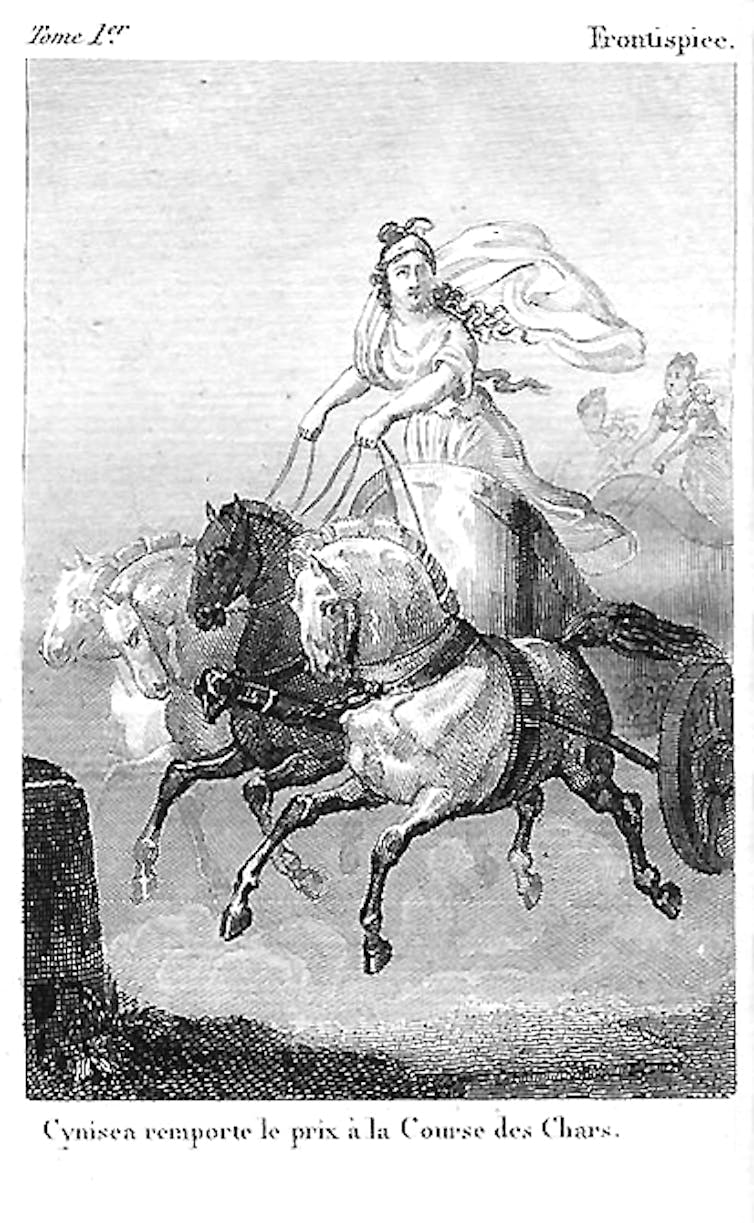
Kyniska (or Cyniska), a Spartan princess, was the daughter of King Archidamus II and sister to King Agesilaus.
She owned a sizable estate where she bred, raised and trained horses, and in 396 BCE, when she was probably between 40 and 50 years old, she became the first woman to participate in the Olympic Games.
Spartan culture believed stronger children come from parents who were both strong, an unusual concept in Ancient Greek society. Spartan authorities encouraged women to train both mind and body.
Unlike Athens and the other Greek city-states where girls were hidden from the public and learned only domestic skills, Sparta held races and trials of strength for girls as well as boys.
Kyniska’s childhood would have been full of athletic training: running, jumping, throwing the discus and javelin, perhaps even wrestling.
Spartan girls married later, allowing more years in education. Aristocratic girls such as Kyniska learned poetry and also trained to dance and sing competitively, so she may have even been literate.
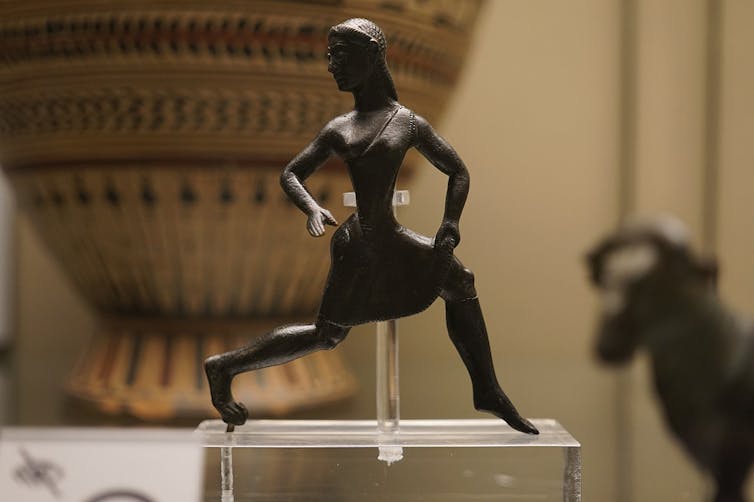
Kyniska had wealth and status – but it was her ambition that made her a legend.
This ambition drove her to compete in the four-horse chariot race, or tethrippon, at the Olympics in 396 and 392 BCE.
Her chariot team won both times.
No Women Allowed
This feat was especially impressive because women could not even step foot on the sacred grounds of the Olympic Sanctuary during the festival. Married women were forbidden on penalty of death from even attending as spectators.
To compete, Kyniska cleverly exploited loopholes.
In sports like wrestling or javelin, the victors individually competed on the field. In the chariot race, the winners were the horse owners, not the riders – who were almost always slaves. Much like with the modern Kentucky Derby or Melbourne Cup, the victors are the horse and its owner, not the rider.
Kyniska didn’t have to drive the chariot to win.
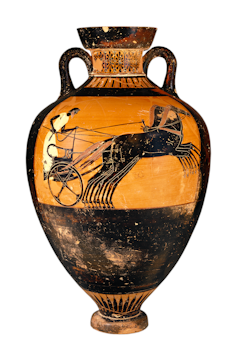
In fact, chariot team owners did not even have to be physically present at Olympia during the games. Kyniska could enter her chariot team in the race without ever stepping foot on the forbidden sacred grounds.
But Kyniska’s role was not secret. News of an Olympic victory was carried by fast messengers to the victor’s home city, where preparations to celebrate their return were begun at once. News that a woman had won an Olympic contest would have spread quickly.
What motivated a Spartan royal to break through the difficult glass ceiling of male-dominated Olympic competition and culture? The scant sources we have offer different opinions.
The Greek writer Pausanias said Kyniska had personal ambitions to win at Olympia, but Xenephon and the philosopher Plutarch credit her brother, King Agesilaus, for pressuring her to compete.
The answer may involve a bit of both.
Her Legacy
Many ancient Greek women won Olympic victories after Kyniska, but none were as famous as she.
Kyniska erected at least two life-size bronze statues of herself at Olympia. The inscription on a remaining fragment of her marble statue base reads:
Kings of Sparta were my fathers and brothers. I, Kyniska, victorious at the chariot race with her swift-footed horses, erected this statue. I claim that I am the only woman in all Greece who won this crown.
Kyniska relished her fame. Agesilaus may have been the catalyst, but Kyniska herself probably decided to compete – at least the second time.
Other women would go on to compete in the chariot races, and by the 1st century CE women were competing directly against men in foot racing events – and winning.
The fact Kyniska didn’t physically compete has caused history to discount her achievements, but this argument marginalises her larger accomplishment. Amid enormous cultural barriers, Kyniska broke gender norms and glass ceilings.
By boldly and proudly celebrating her trailblazing victories with commemorative statues, she transmitted this message to women across the Greek world.
Fuelled by Spartan pride, Kyniska’s accomplishment to be the first woman to compete, and win, in the male-only Olympics is a startling and memorable achievement that deserves a prominent place in Olympic lore.![]()
Todd E. Caissie, PhD Candidate in Art History and Cultural Heritage and Preservation Studies. Lecturer, Rutgers University
This article is republished from The Conversation under a Creative Commons license. Read the original article.
New 10 Year Strategy To Support 850,000 Carers
Osteoarthritis Biomarker Could Help 300 Million People Worldwide
Grief And Trauma Support For Australia's Aged Care Sector
- The Australian Centre for Grief and Bereavement will provide specialist information and support to residential aged care and home care recipients and their families who have been affected by COVID-19;
- Phoenix Australia – Centre for Posttraumatic Mental Health will deliver a sector-wide trauma-informed care package that provides trauma training and resources for aged care residents, their families and aged care staff, including through the establishment of a dedicated website; and
- Dementia Support Australia will implement a proactive engagement program to help alleviate the impacts of lockdown on aged care residents living with dementia.
Cancer-Killing T Cells 'Swarm' To Tumours; Attracting Others To The Fight
Computational Approach To Optimise Culture Conditions Required For Cell Therapy
Which Is More Creative; The Arts Or The Sciences?
People Can Do More Than Use Less Plastic To Help Save The Great Barrier Reef
The Black Hole Always Chirps Twice: New Clues Deciphering The Shape Of Black Holes
Disclaimer: These articles are not intended to provide medical advice, diagnosis or treatment. Views expressed here do not necessarily reflect those of Pittwater Online News or its staff.